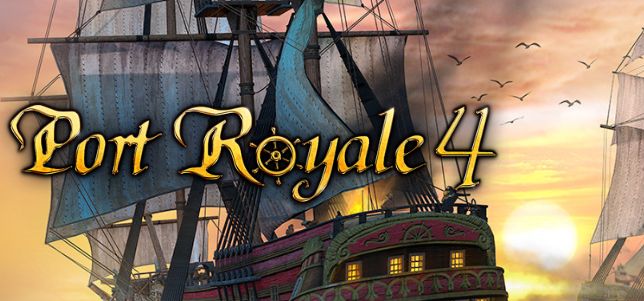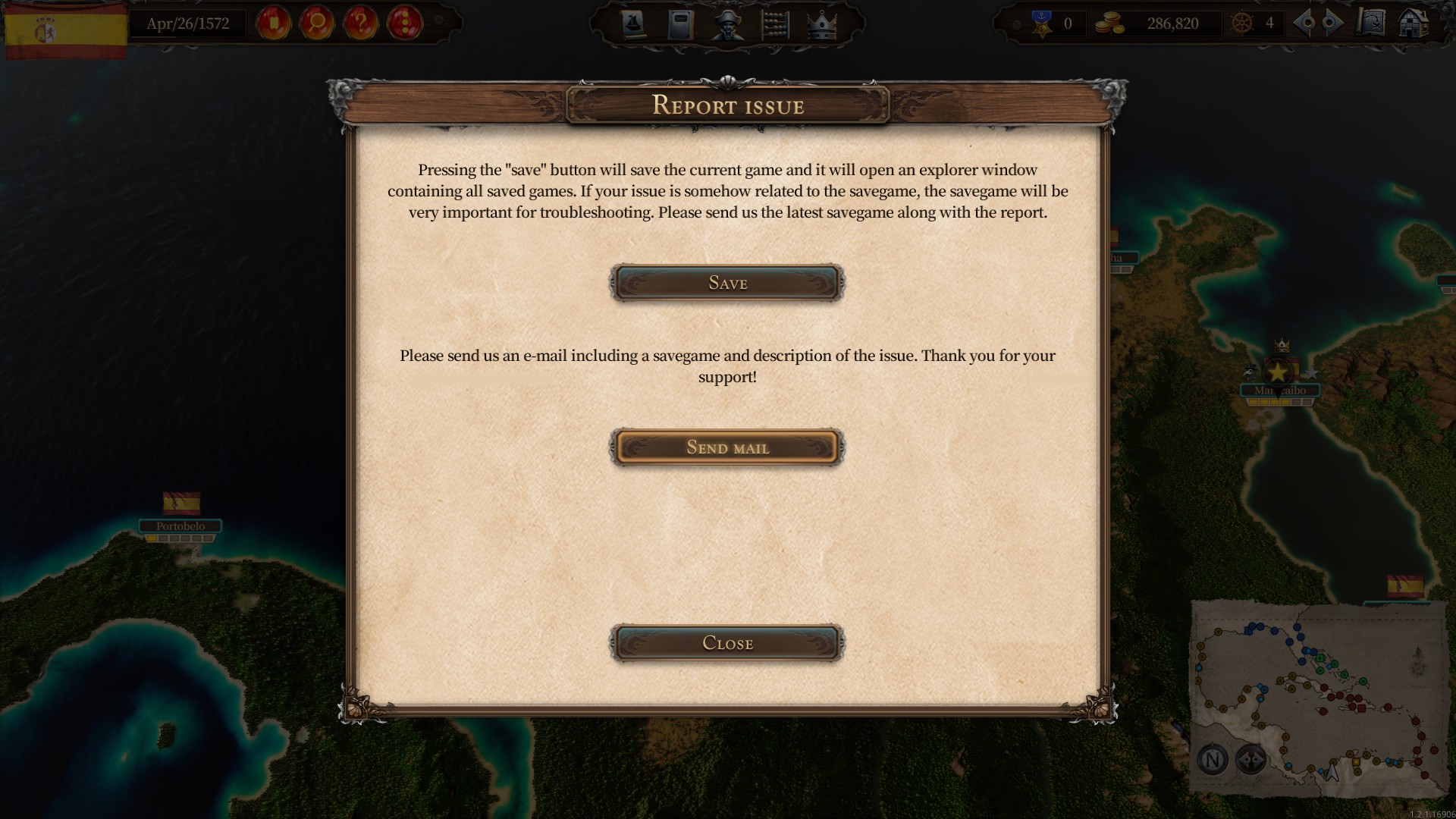Colonialism, automated. Wake me when the automation actually works.
Type: Single-player
Genre: Simulation, Strategy,
Management
Developer: Gaming Minds
Publisher: Kalypso Media
Release date: 25 Sept, 2020


Intro
Last time, I did a retrospective on the Patrician series, and what makes it work so well. I had been wanting to do that article for a while just because it’s a rant I wanted off my chest, but having the chance to review Port Royale 4 gave me the impetus to hash it out, just so I could have my feelings about the general series before talking about its newest iteration. (Port Royale effectively grew out of Patrician, as did Rise of Venice, being basically the same game in a different setting.)
I therefore don’t come to this game the same way Aurumlamina’s preview was written as a newcomer to the series. I have some seriously mixed feelings about the series, as it is a fantastic series I enjoy quite a lot, but I’ve also felt that after being bought up by Kalypso, the series has largely stagnated between games, overly simplifying things that should be getting more detailed and making the games more “gamey” when they could be creating a more vibrant simulation.
The Franchise(s)
Those of you who have played Port Royale 3 or Rise of Venice can skip to the next section. If you’re new to this kind of management game, here’s the basics of how it goes:
You start out as the manager of a colony, owning one or more ships, and having enough money to buy several whole apartment complexes. (It depends upon your difficulty/starting settings.) Thus already being richer than most people will ever be, you set out to become unimaginably wealthy. You use the money you have to buy goods you buy low and sell high. You use this money to buy more ships so you can buy more low and sell more high. When eventually you have run out of goods to buy low, you can use the fabulous wealth you have to expand the city you control, build new factories, hire workers, and then sell the products high. You use that wealth to get the rights to develop and run other colonies, too. Eventually, you start building an armada and conquering the Caribbean so you can manage all the cities, so that you can make all the money. Then you… umm… just sit there and continue to make more and more money, I guess?
There are 25 commodity types (plus sailors/”job seekers” that kind of act like a commodity), and every colony consumes a certain amount of each commodity per day based upon its population. The price a colony will pay for a commodity is based upon its (fixed) base price, multiplied by how much supply a colony has of that commodity. Colonies generally want at least 20 days of supply for every commodity, and satisfaction/prosperity (which is important for expanding your colonies) depends upon having all its needs met. At the same time, you make the most money selling to a colony when it is nearly or completely out of a commodity. Due to the way that the game is balanced, colonies need to expand and have more population (which increases demand) to run more factories that produce more goods to satisfy the increase in demand. Because every commodity’s demand increases slightly with every increase in population, but the amount of a single commodity shoots up quickly with even one more factory, building more than one of any given type of factory before building one of all other types of factories will lead to an imbalanced economy where there is a permanent shortage of the commodities whose factories you don’t build while there is a permanent glut of the commodity whose factories you did build.
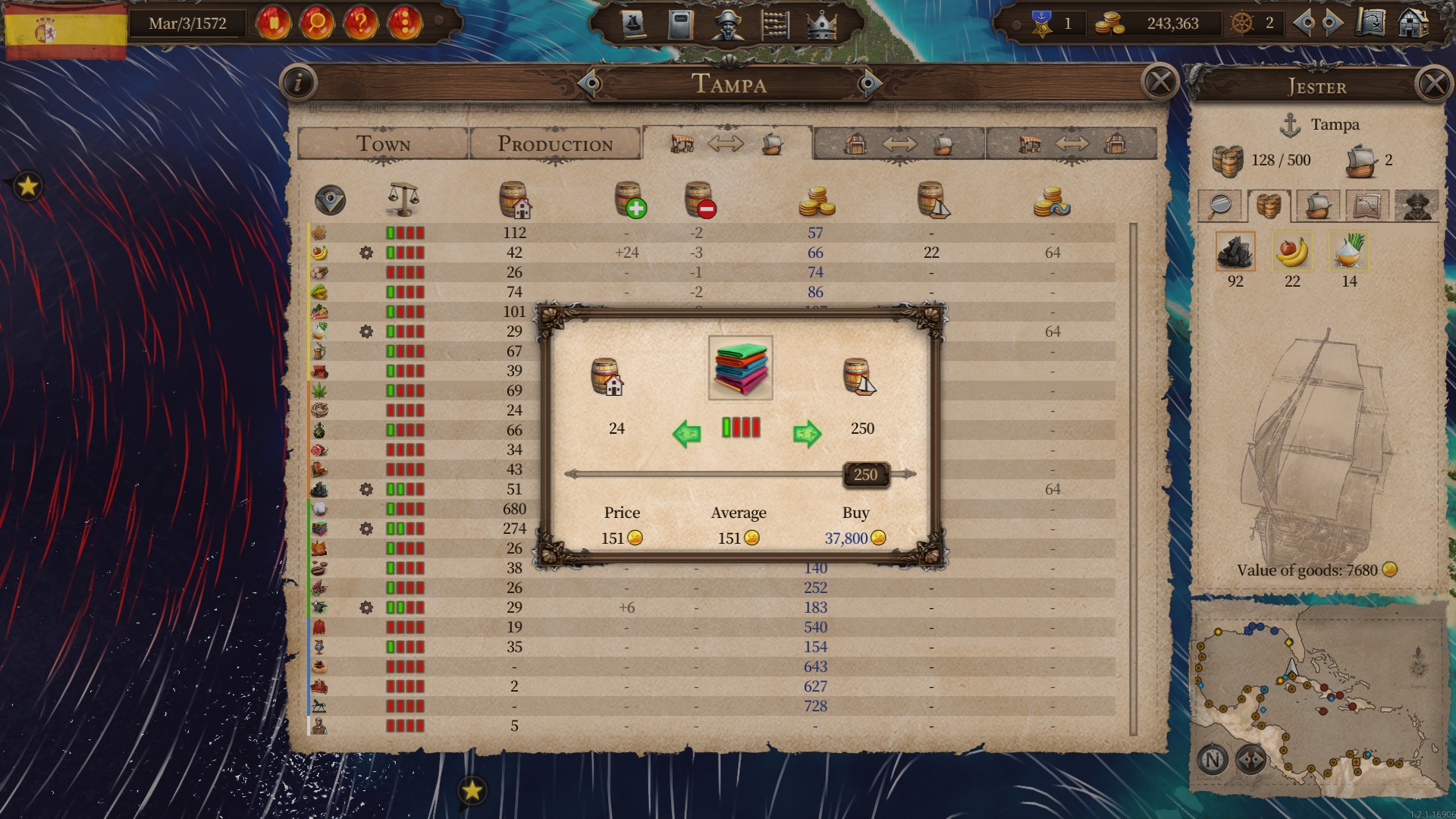
I mentioned back in the Space Station Manager review that just making money so you can spend it on capital that only makes you more money is a bit of a boring gameplay loop. You can basically explore the extent of what the game allows you to build, and then get bored because the game is simply earning money in a loop over and over past that point. Waiting until you get your first capstone building is interesting, but when you’re building twenty of them, there’s no reason to keep going on.
So, to add to this, Port Royale 4 still manages to hold on to some vestigial alternate gameplay elements from previous iterations, although those hoping for the variety of Sid Meyer’s Pirates! will find Port Royale 4 a bit lacking. Naval combat definitely exists, and is by far the most fleshed-out of the lot, although I’ll cover that in its own section, below. The city-building is a sort of mini-game to let you maximize the efficiency and happiness of your population, however that only serves to feed a bonus to your money-making empire, so it hardly rises to the level of being a distraction from the money-making empire. Beyond that, the only reason not to automate all your ships aside from the combat fleets is that there are random events that pop up as little stars.
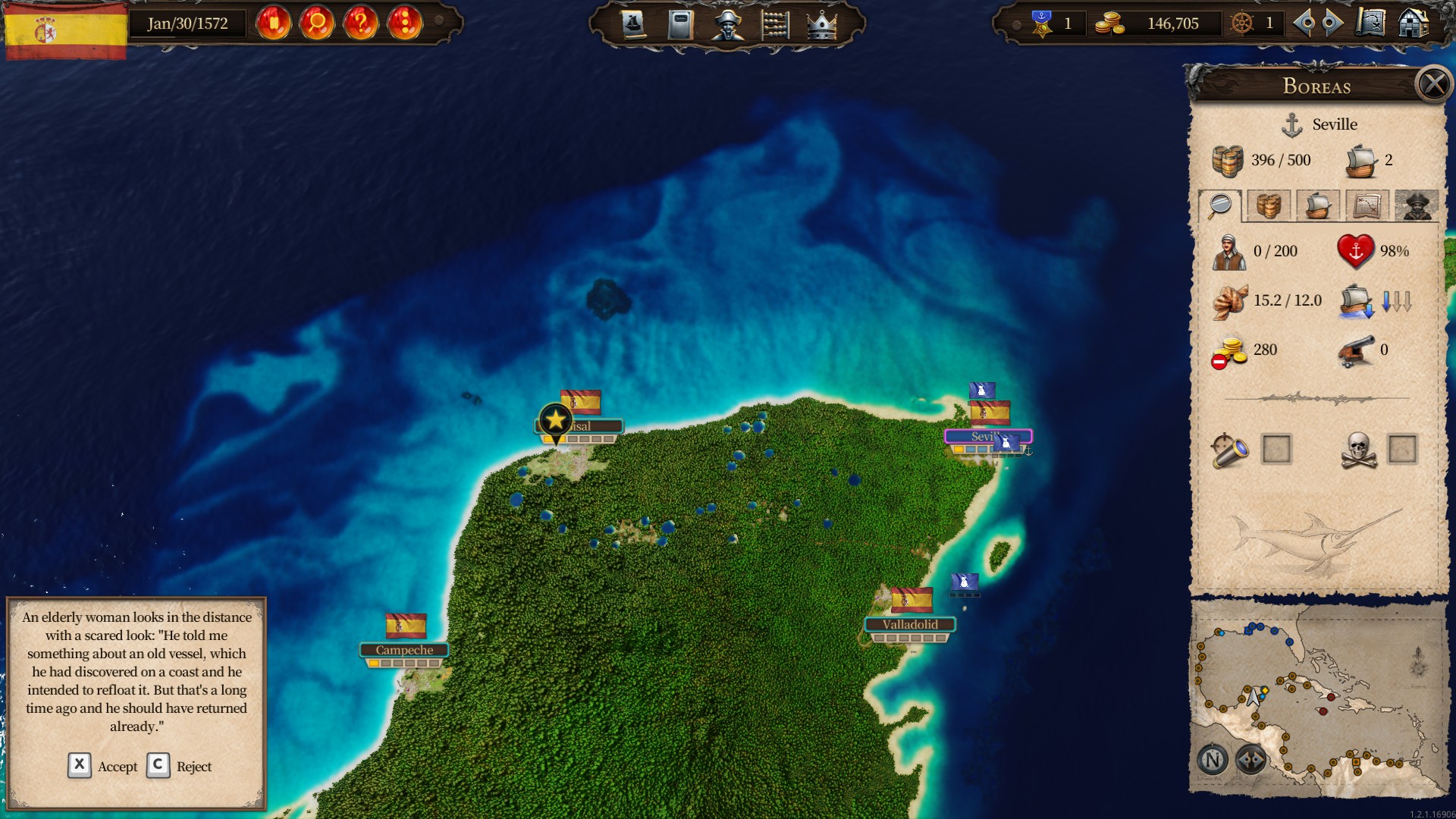
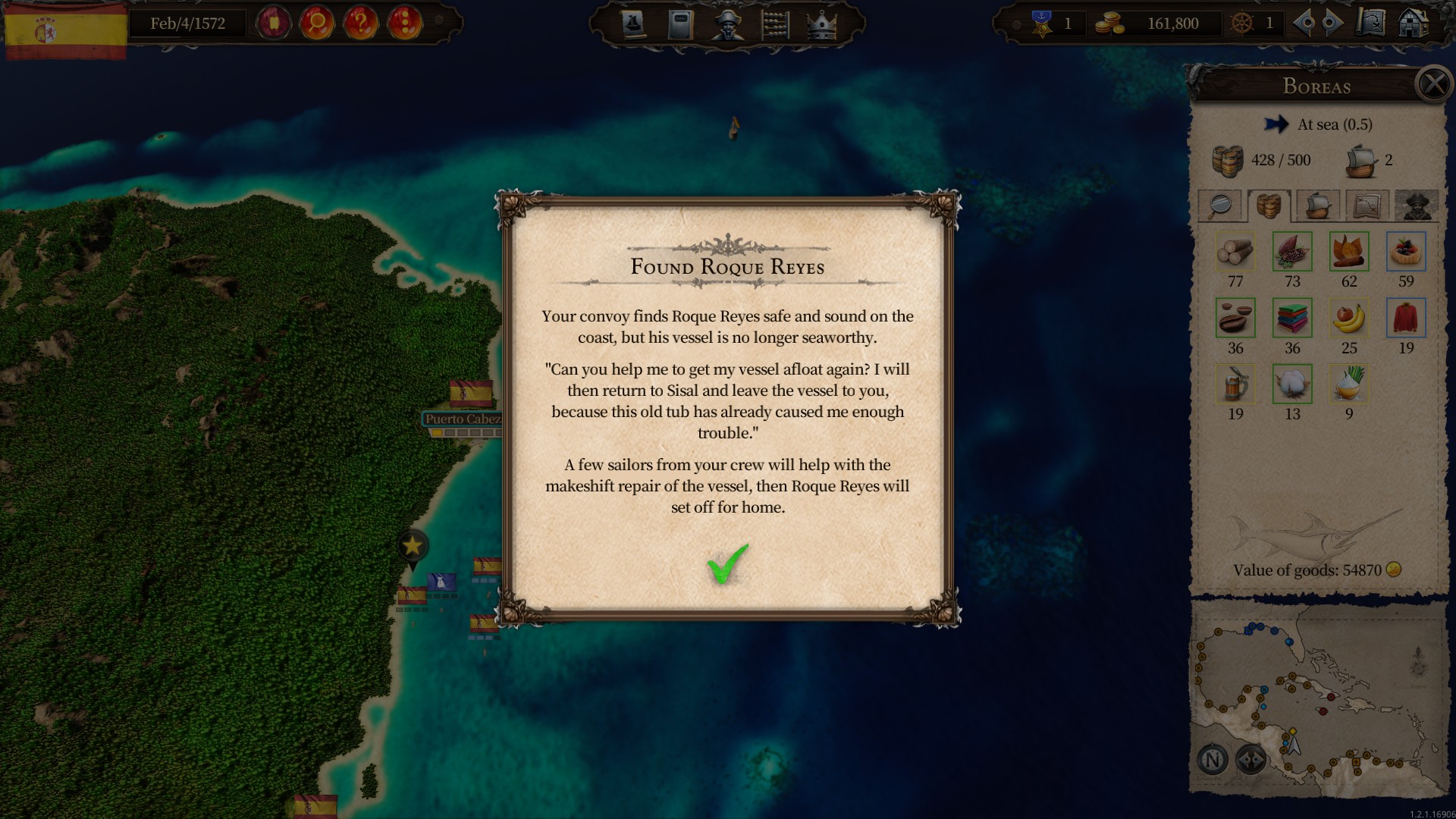
Automation, however, is a major element of the series going back to its founding, which is notable because concepts like players writing scripts for their units behaviors was novel stuff back in the day, although the series has largely stagnated on this front for the past couple decades. Compared to previous entries, the game at least does make the game faster to automate, without needing to set so many things manually, which is a welcome change. (Although there is a “difficulty setting” that lets you make things more tedious for no reason, more on that later.) The problem is that, while Gaming Minds seems to be working on it, the automation seems to be making some questionable choices as of the launch version.
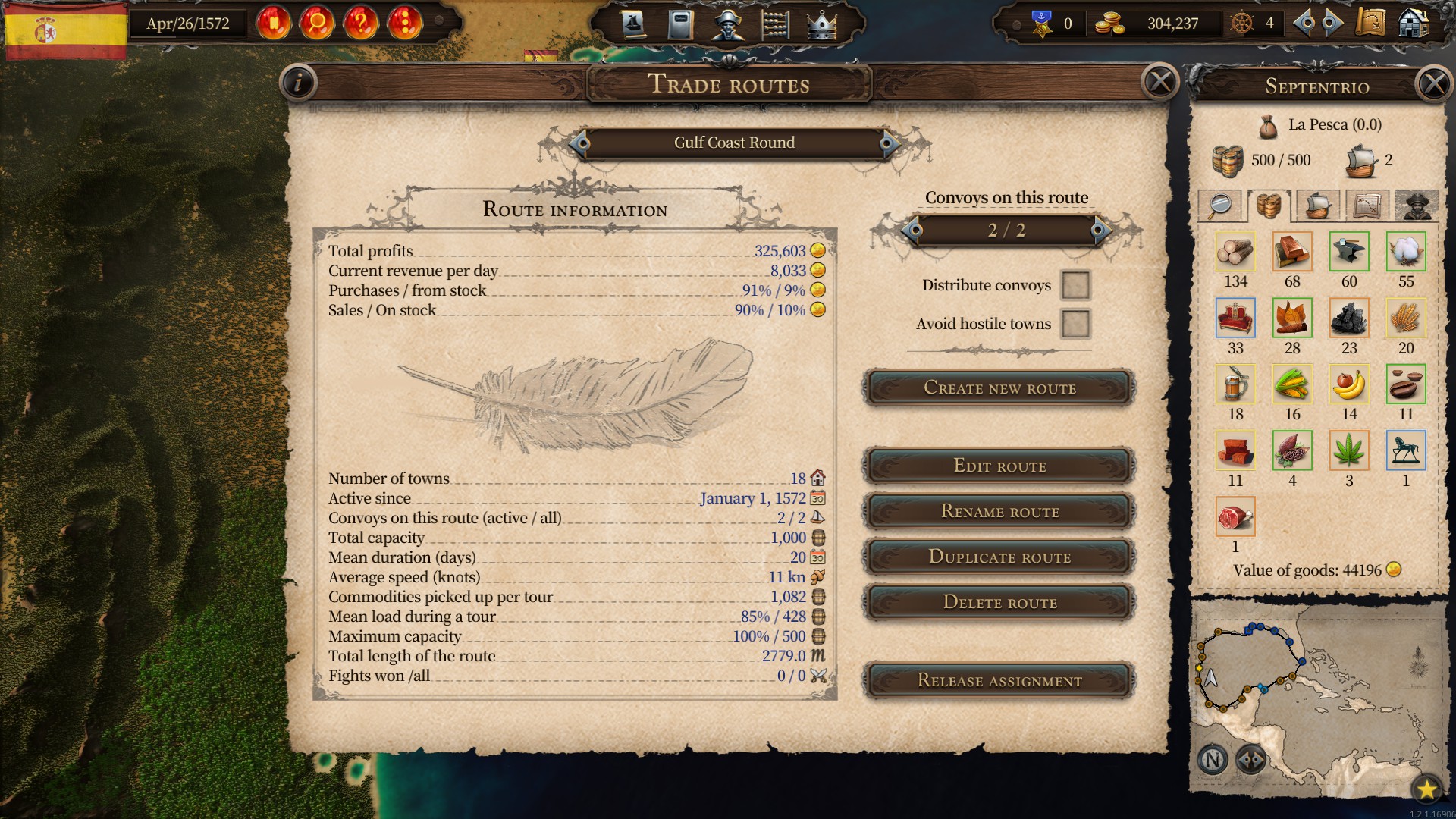
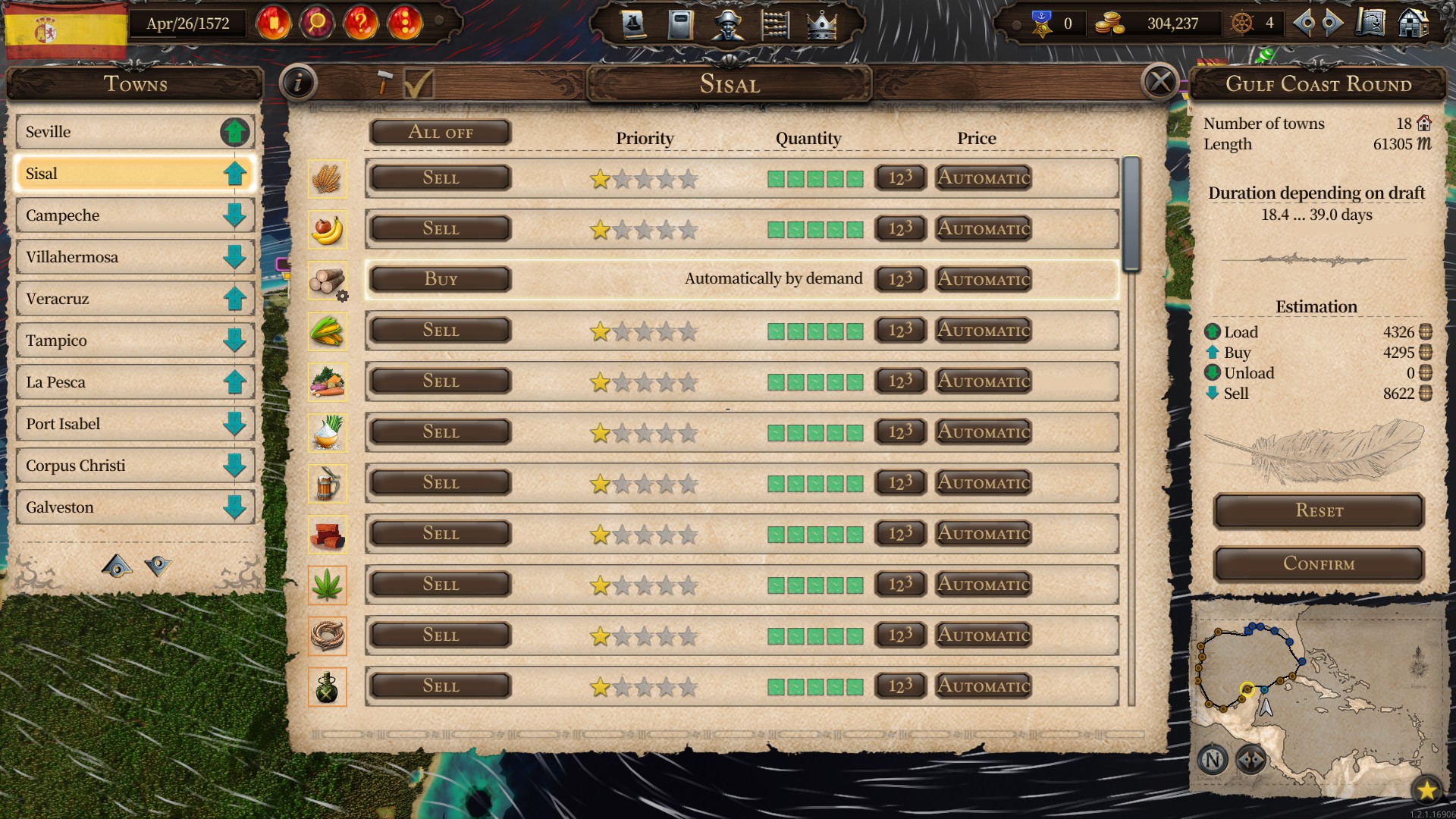
Using automation allows you to buy new ships, throw them into convoys, and send them running buy-and-sell routines across the map without adding anything to your mental load. In fact, because you have to constantly pause the game to trade manually, how fast the game proceeds can generally be tied directly to how many of your ships you’re letting run on automation. Automate everything you can, if only for your sanity!
You can let ships follow trade routes that just buy low and sell high at first, but as you build your own colonies up, a top priority is keeping them well-supplied. This means setting up new trading routes that send your ships out only to ferry the supplies your colony needs to continue production.
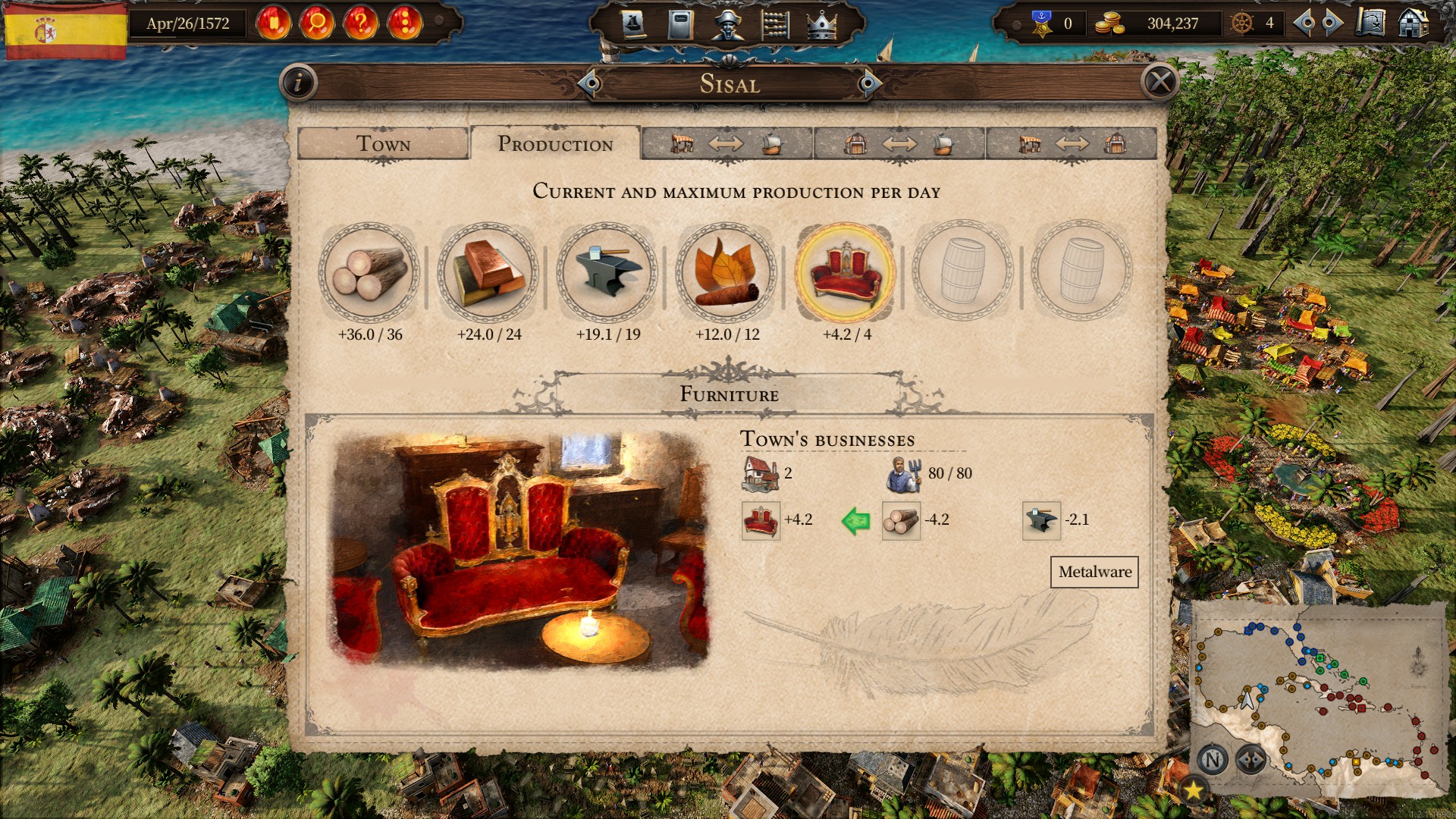
What’s New?
For those of you familiar with the Port Royale series, in a nutshell, almost everything is going to be very similar to Port Royale 3 and Rise of Venice. It’s a common refrain among Kalypso games, but they really do just rerelease the same game with a fresh coat of paint so they can sell you new DLC every five or so years. That said, while the core mechanics and gameplay loop are the same, many of the side elements are completely rebuilt, and I find most of them to be at least a baby step in the right direction.
One of the most significant changes is the new turn-based combat system. This seems to be a rather controversial change, as the combat in Port Royale 3 was real-time and technically skill-based. That said, it was also hands down the worst part of the game! I therefore see this as a rather welcome change, and I’ll be going into it in more detail in the next section.
Beyond that, another of the bigger changes from Rise of Venice is that the “seamless transition from world map to city map” now has an actual meaning. Whereas Rise of Venice eliminated city-building as anything but a spreadsheet manager, thus made zooming in on cities completely pointless, thus making the “feature” worthless, Port Royale 4 reintroduces city management. Unlike Port Royale 3, where it only made an aesthetic difference where you placed factories, Port Royale 4 adds productivity bonuses back in from the older games, making it so that factory placement has an impact upon resident happiness or factory productivity. (Residents hate being within two hexes of mines and farms, and residences house triple the population if within two hexes of both a tavern and chapel.) This leads to an optimization puzzle in city planning, which also is muddled by players only having full control over the construction in colonies they directly administer.
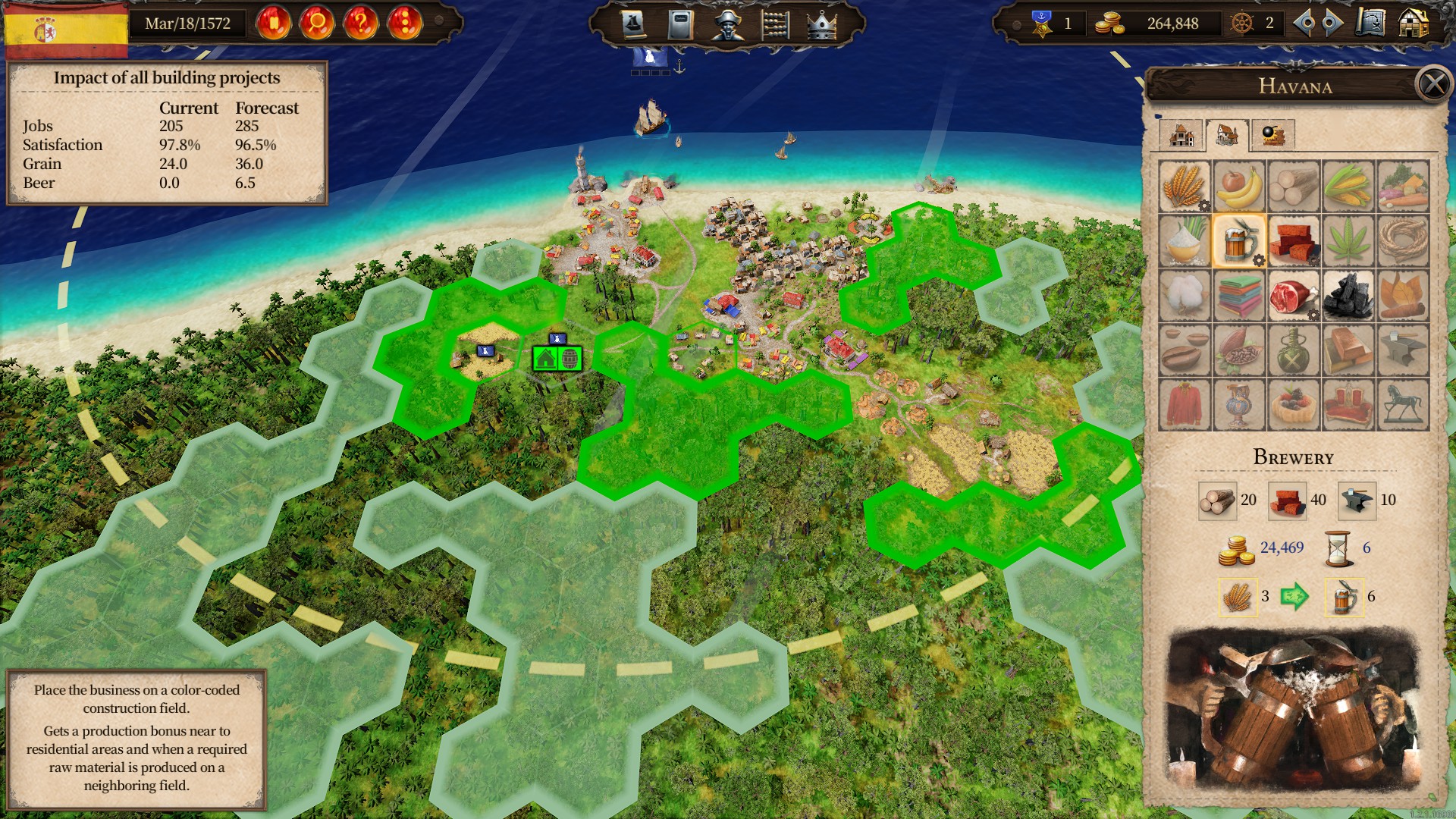
Also, titles are done away with. Fame now replaces most of the title-seeking tasks, and fame is somewhat more flexible than titles, which often had specific demands for certain amounts of trade or combat, regardless of the player’s own playstyle. That said, it’s also the bane of many players’ existence because of a new demand that you maintain a 40% share of all trades in any port you manage or else face a -2 fame per day penalty that can end your game because of an arbitrary nonsense mechanic.
Whereas previous Gaming Minds games had five products per city, in Port Royale 4, there are four raw material products per colony and seven slots for production. Manufactured good factories can now be built in any colony (clearing up one of the most strange gamey elements of the previous games where you couldn’t just bake the bread in the same city wheat was grown, and instead had to ship it out to a city that somehow possessed a special power to allow bakeries to exist), although they take Concessions/Fame Points to unlock. These can fill up the seven slots of production for a colony, and not all colonies start out with all four of their potential raw materials even being exploited. In a throwback to Patrician 3, there are even some colonies that have 10% bonuses or maluses to specific raw material production, making some colonies prime production locations. A colony with 110% cotton production, for example, is a great place to build cloth weaving mills and clothing factories, as you can produce all three goods in a single colony with production bonuses without needing to get any ships involved for supply maintenance. Their only job is exporting all your products for profit, now!
One more significant change is that there are prevailing winds on the map, now. Pressing Alt makes them visible, and in certain red areas, storms that damage your ships are common. Because the wind multiplies your speed by between half and one and a half normal, there’s a powerful incentive to follow the prevailing winds when setting up your trade route. Going clockwise through the Gulf of Mexico is much faster than counter-clockwise. Sadly, the winds are mostly coming from the southeast in all other areas, so you just have to go against the winds, regardless.
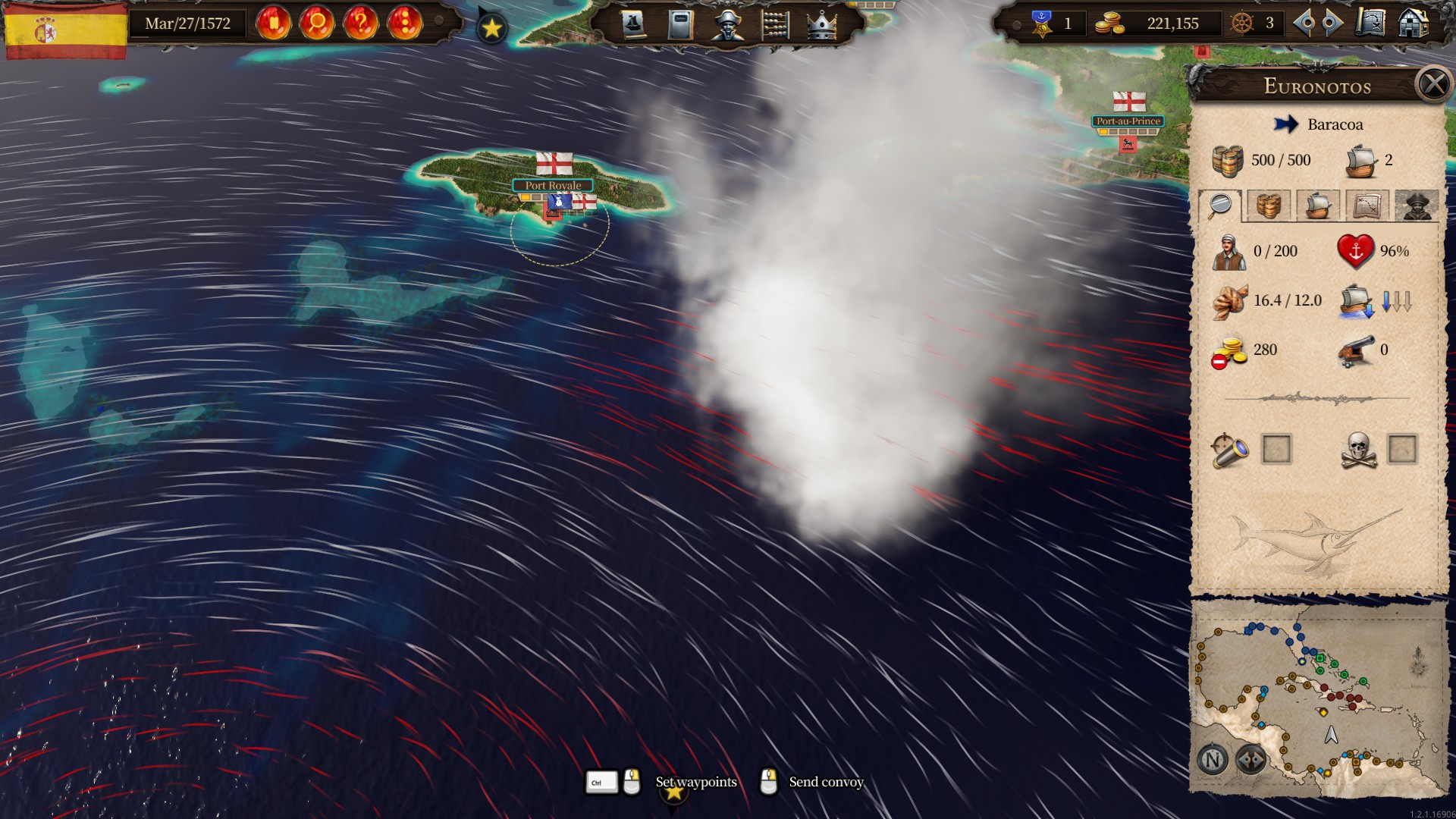
In all, however, many of the changes feel like they carry on the trend set by Rise of Venice in making the game less a simulation and more a “gamey game”. At least you don’t need to be of a count’s rank to be trusted with buying bread all by yourself anymore, but you now have to ask for “concessions” using “fame points” to do things that are faction-unique.
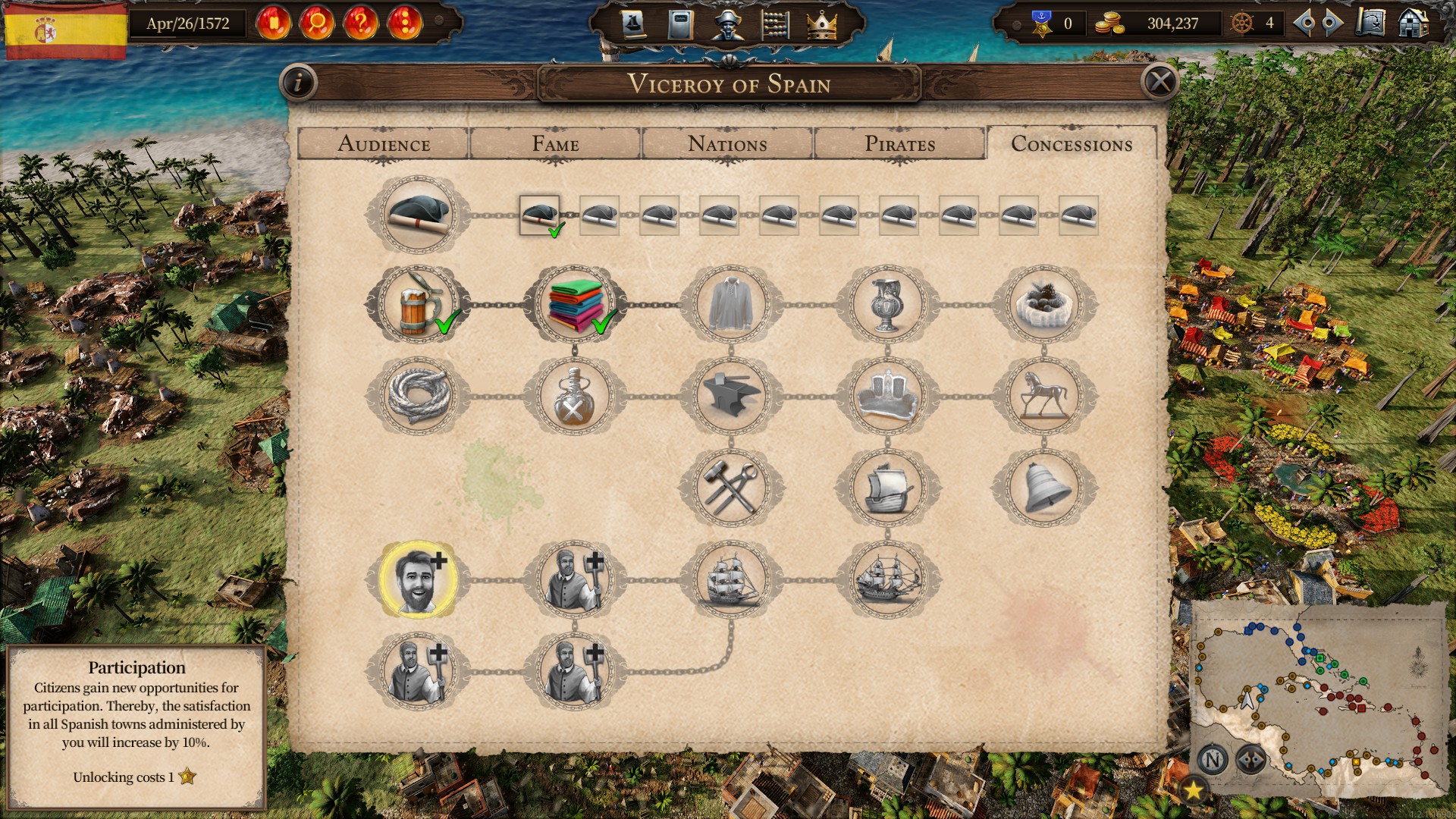
The Combat
For some reason, it seems controversial that the Port Royale 3 real-time combat system was scrapped for a turn-based combat system. This was something that needed to happen, however, and this is why:
Port Royale 3 combat basically makes you choose between playing the game correctly and being bored out of your skull, or playing the game wrong and at least getting the worst part of the game over with quickly. Port Royale 3 combat, you see, is trivially easy thanks to the stupidity of the AI. All you need to do to win every battle without taking damage is only have one ship set to fight even if you have multiple ships to help carry more chain shot and canister shot. At the start of battle, simply turn around and run from the enemy. The enemy is run by a script which has two modes: Attack mode when you are close, and chase mode when you are far away. In chase mode, the enemy ship just sails at you. In attack mode, the enemy ship turns to try to fire at you because it can only fire directly left or right of itself (no “long nine” to fire forwards like real ships did). If you sail away and then turn broadside until the enemy gets close, you’ll be in firing position, while the enemy is out of position to fire. Immediately after firing, you just turn around and sail away again as the enemy turns back to face you because you ran too far away to shoot at, so it goes back to chase mode. Rinse and repeat until you win and as long as you don’t linger, the enemy will never get a chance to fire. If you fire chain shot to rip sails, then fire canister shot to clean the enemy ship of crew then board, you’ll be able to get all their ships at a steep discount (provided you have enough chain and canister shot)! It’s the best way to make tons of money very quickly in game time…
You can literally win a battle against any enemy fleet with nothing but your starting ship like this. The only problem is that a single battle takes seriously as much as a whole hour to win properly. It’s the quickest way to earn money in game time but by far the slowest, most grueling way to earn money in your much more precious real life time.
Or you can be an idiot and bring allies in to die, while losing money hand over fist for sunk ships while gaining no new ships from boarding. (For that matter, you can auto-battle to really play the game wrong but fast! Auto-battle is amazingly brain-dead, but at least it doesn’t make you dead inside!)
Play the game right but hate the game, or play the game wrong and at least get back to the fun parts quicker – your choice!
This is why scrapping that godawful system is definitely the right choice, even if there are some people who for some reason liked spending literal hours chip damaging galleons to death.
The new system is a turn-based one with an I-go-you-go system, although every ship gets one turn before the first ship gets its second. So, for example, if one side has three ships and the other has two, after two ships on both sides go, the three-ship side gets two moves in a row.
Every ship has a certain number of movement points and turning points per turn, and can fire out both sides once per turn – or twice a turn if you use a “tactic”.
Because there is no longer a way to fire then run away quite so easily, battles are slightly more “fair”, but they still aren’t quite hard. You can still easily win battles where the power meter says you are outgunned two-to-one easily by just spamming tactics, especially since the enemy only uses solid shot while canister shot followed by boarding is both vastly more effective and more profitable to boot.
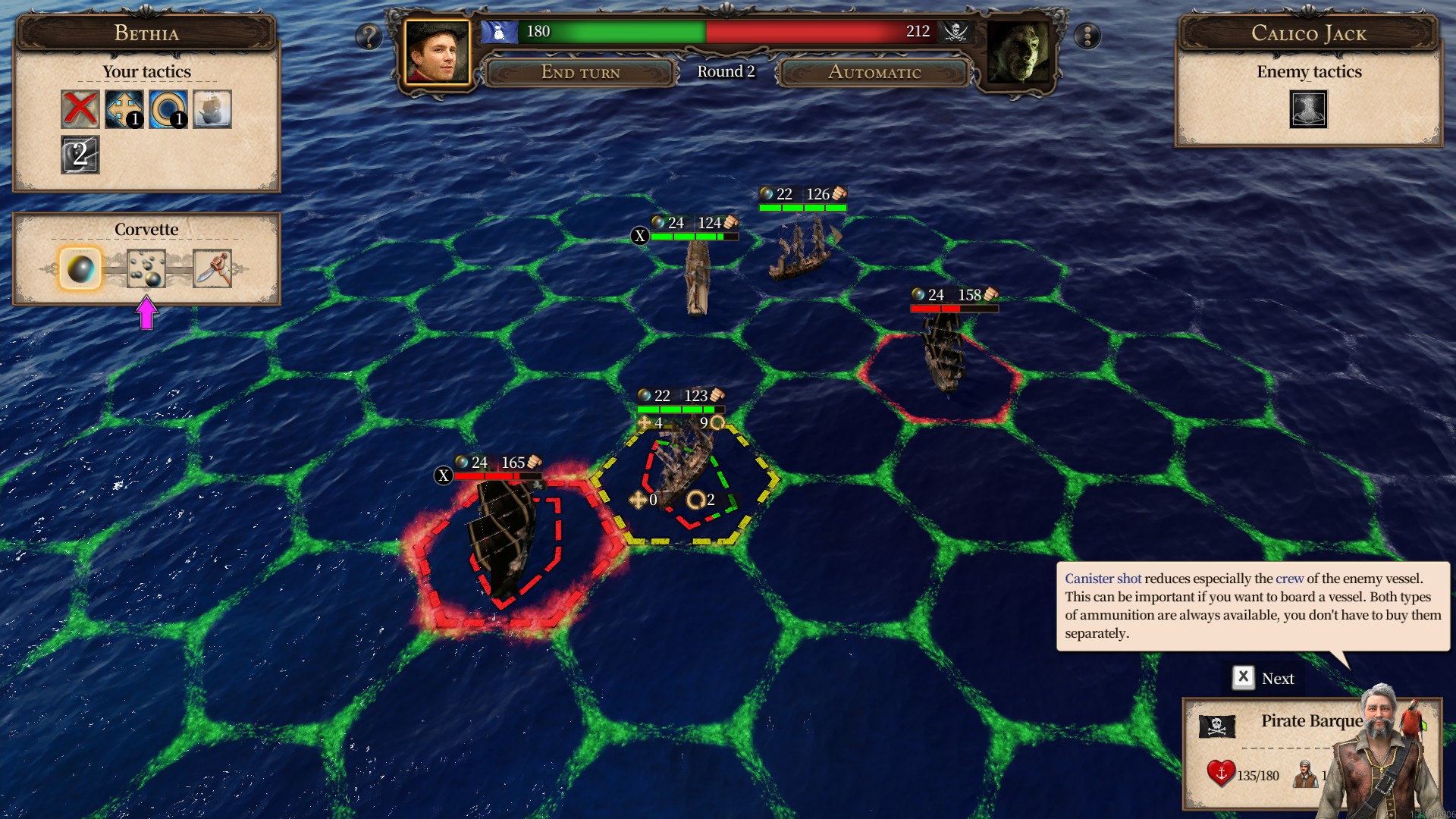
“Tactics” are a toolbar on the top left of the battle menu, and can be used at any time during your turn to give yourself more movement points or reload and fire twice. They are extraordinarily powerful, and the “Captain Tactics” you get as a reward for random task completion are capable of easily overturning even battles where you are seriously outnumbered by giving you free turns or healing damage to your ship for free mid-battle. They require doing more tasks between battles to recharge, but if you aren’t getting into many fights, you hit the caps on them, so you might as well use them any chance you get, and they make battles a cakewalk. That said, if you’re in a nation at war (especially a small nation like the Netherlands), you can suddenly be mobbed by dozens of hostile fleets, and have no means of recharging them, making them practically a non-factor. Because the cap is just two per tactic, it’s either feast or famine!
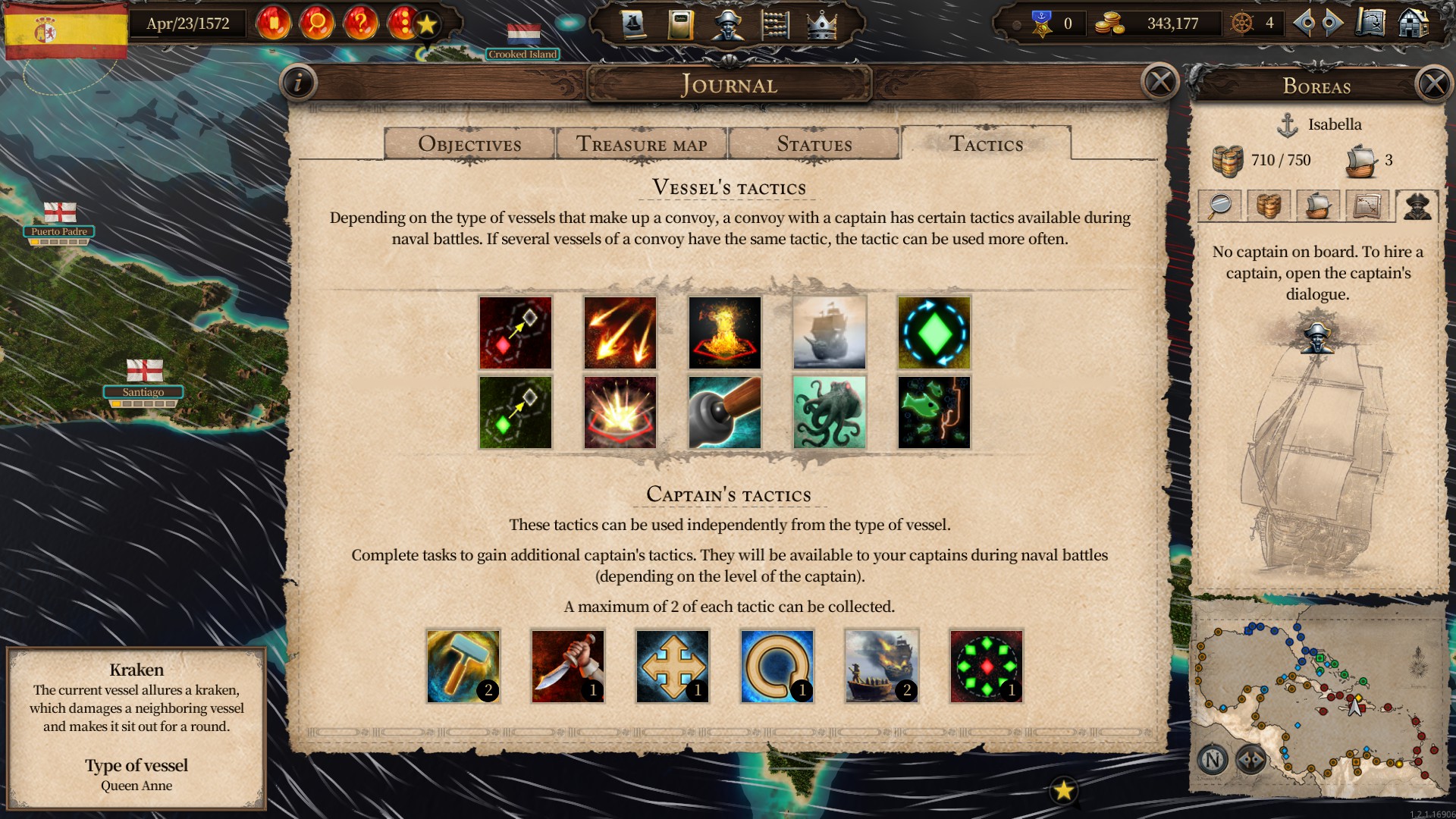
Another [i]significant[/i] problem is that captains now have an effective command limit, with all military ships requiring command points to be kept in your convoys. This becomes a major problem when boarding ships because you have to add a ship to your fleet when you board them (you can’t just scuttle them), and captured ships will push you over a captain’s command limit, forcing them to immediately return to port to dump the ships off so they can be commanded again. In wars where you suddenly have to use fleets to fight off dozens of hostile military fleets, this can make the game basically unplayable at points.
Fame and Fame Points
Yes, in spite of it being incredibly confusing, Gaming Minds actually thought to name two important game concepts entirely too similarly.
In previous games, there were ranks that you climbed up in order to advance through the game. At best, these were just the stages of the campaign in Port Royale 3. At worst, they were tied to locking out basic game functions, such as being able to form more than one convoy or buy the more valuable commodities you would want to trade first in a game for no good reason in Rise of Venice. Port Royale 4 still locks out some of the basic functions in a frustratingly gamey fashion, but not quite as egregiously as Rise of Venice does.
“Fame” (not to be confused with “Fame Points”) is an experience point bar. Completing random tasks or story objectives gives you Fame points that eventually unlock Fame Points. The number of Fame points that it takes to gain the next Fame Point increases exponentially, just like everything in this game series since Rise of Venice. (Your first license will cost you 25 thousand coins, but the last one will cost you 20 million coins…) Hence, your first Fame Point costs 50 Fame points, but the second Fame Point will cost 160 Fame points, and the next is 312 and so on. You gain a couple dozen points a month from trading colonial goods to the viceroy town or 20 or 40 points from a random task, but the Fame costs soon skyrocket into the thousands for a single Fame Point. Have I mentioned that you need to get 10 of these Fame Points to just unlock every factory type and then need more to unlock captains you need to even sail ships with captains to even start to take part in combat?
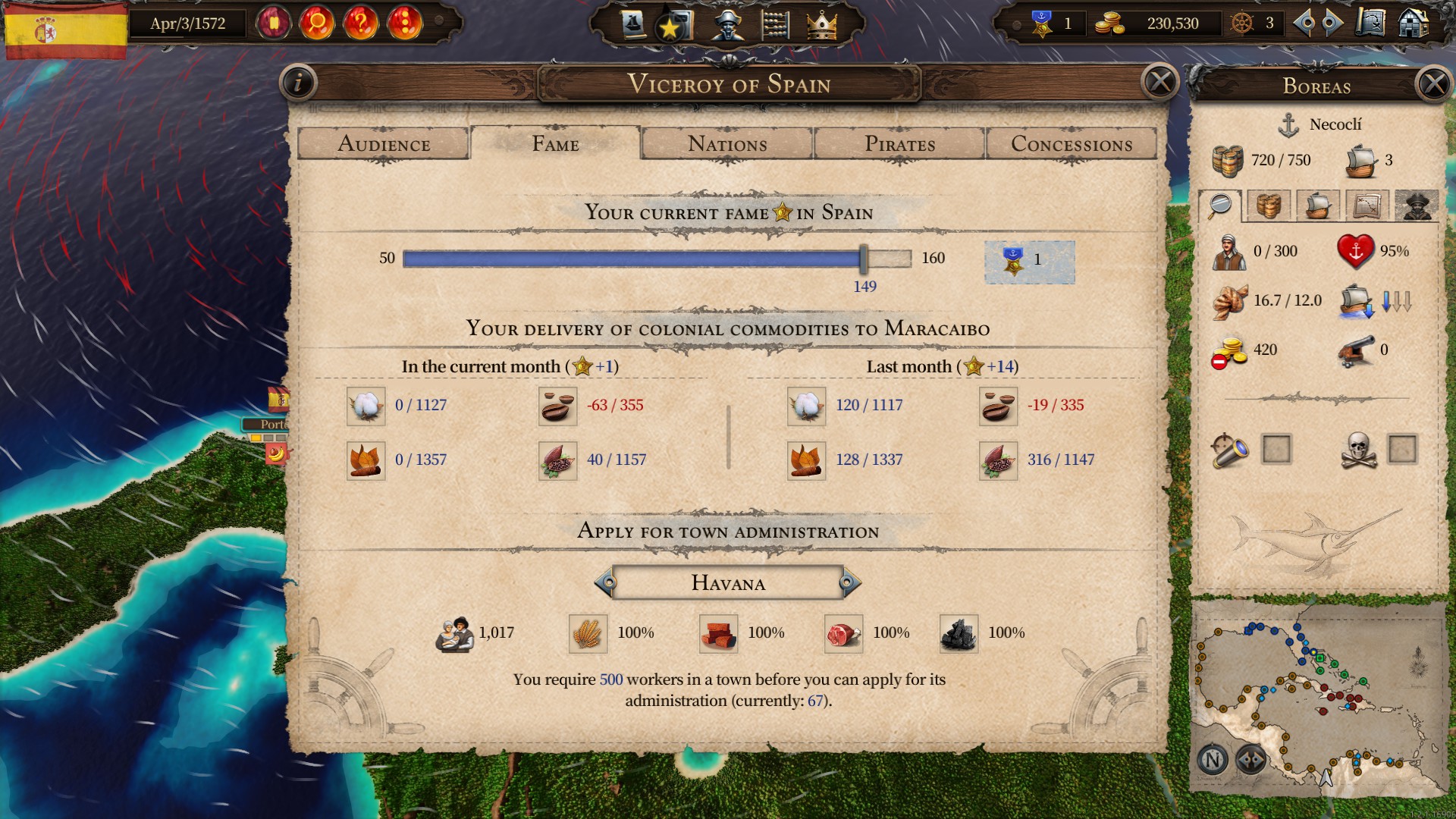
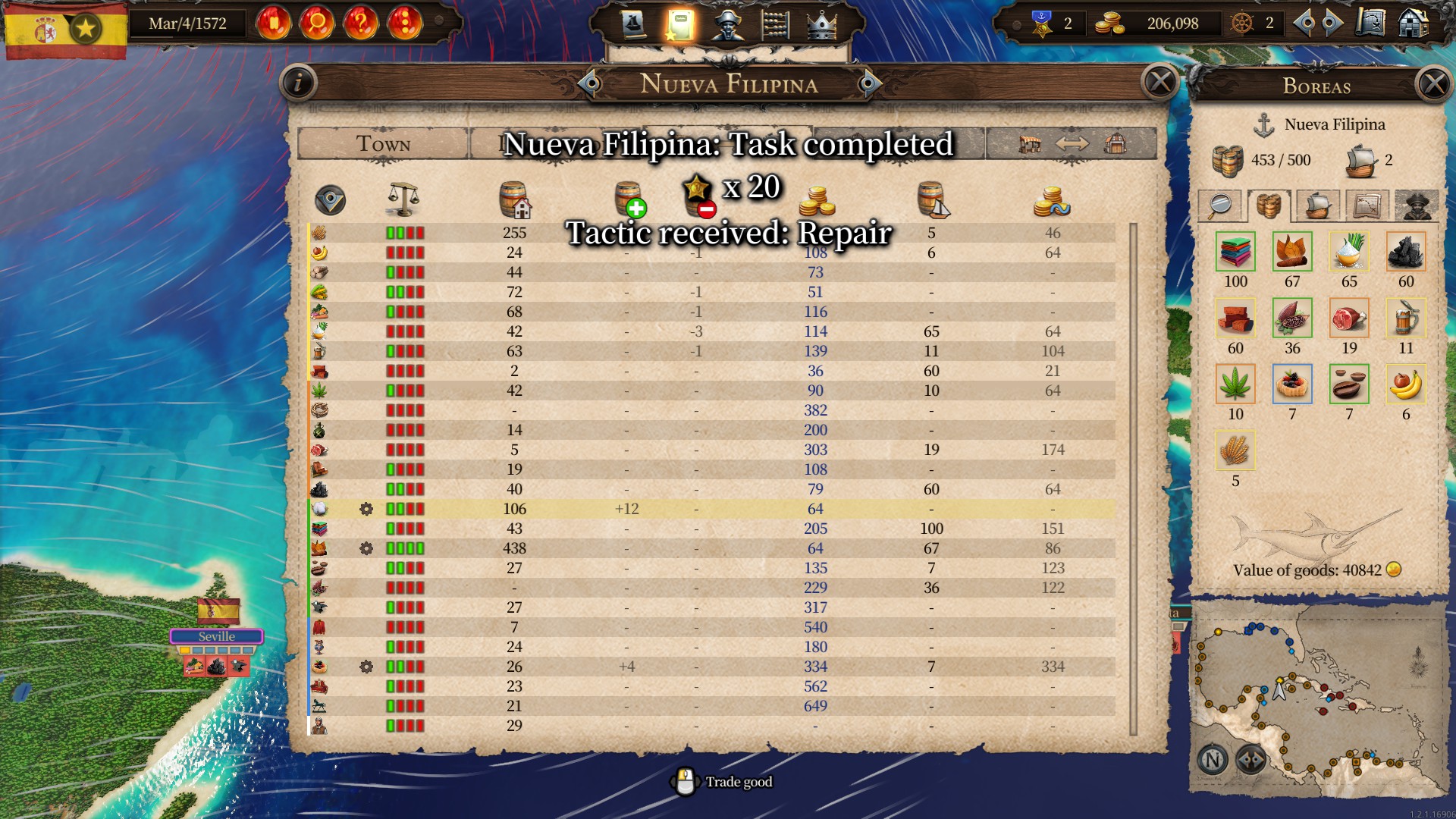
Beyond just completing random tasks, however, you can also simply sell the four colonial trade goods to the Viceroy city of your nation. These are cotton, coffee, tobacco, and cacao. (Strangely, not sugar cane, even though it was the primary export – besides plundered gold – back to Europe at the time.) Notably, none of these are manufactured goods. Viceroy cities will purchase extraordinary amounts of these commodities.
One major pitfall in the game is that when you gain administration of a colony (which you want to have long-term for any colony you are heavily invested in, as you cannot build housing on your own without it), you need to maintain a constant 40% of the market share in that colony. If you fail to keep that up, there is a dreaded “insufficient market share” penalty that will suck away 2 Fame points per day until you reclaim the market share in the colony. You basically cannot gain 2 Fame points per day, so this is absolutely lethal to you, and apparently leads to losing the game for many people as they incur penalties for falling into negative Fame. UPDATE 20th Nov 2020: Due to unanimous hatred of the market share mechanic (they held a poll, literally nobody liked the mechanic), it was eliminated in favor of a bonus to towns where you maintain over 90% satisfaction.
Fame Points are generally spent on the Concessions screen of the Viceroy menu to unlock core parts of the game, like having captains or faction unique bonuses or being able to build factories you need to complete game objectives or just play normally.
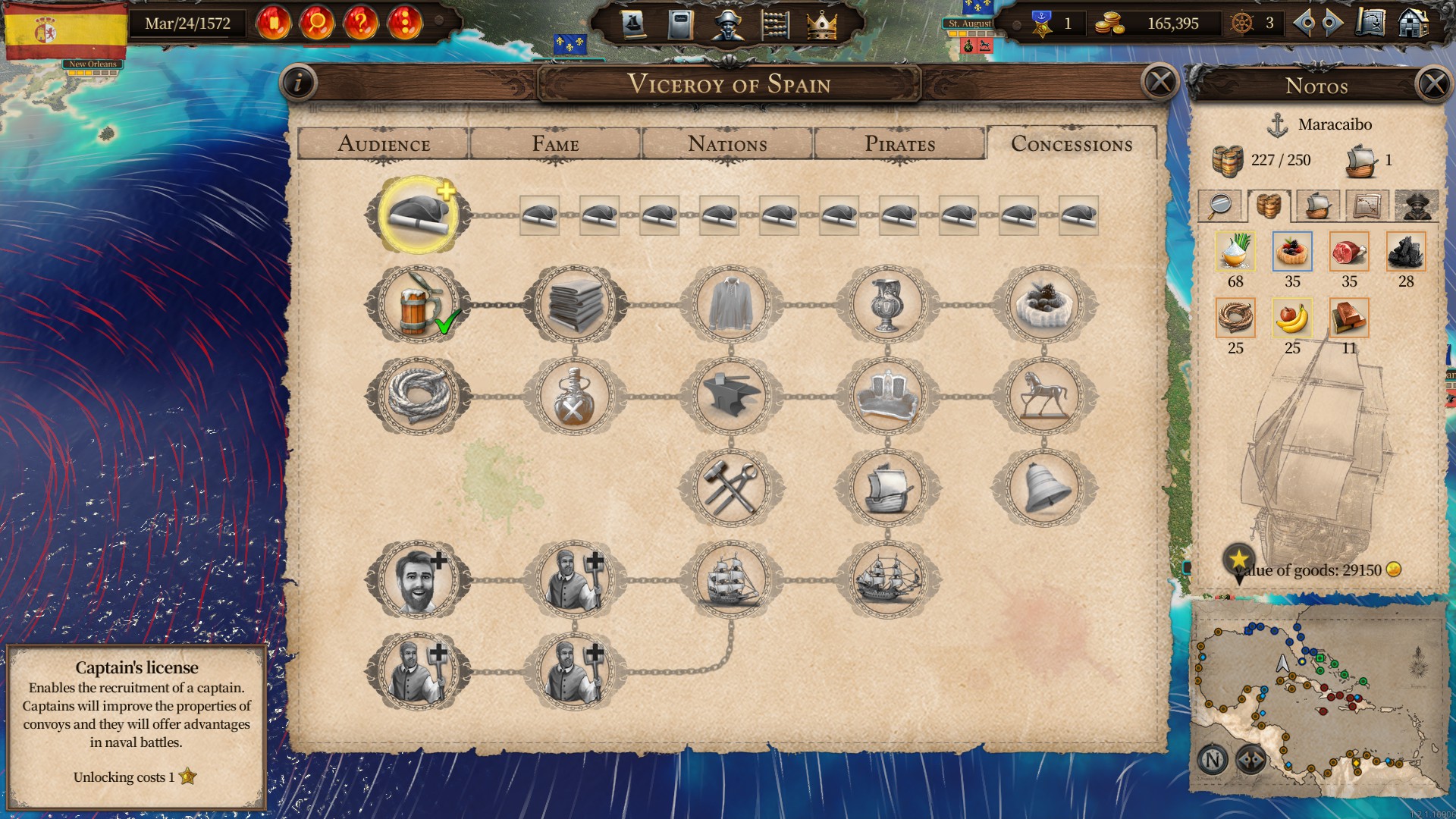
Fame Points are also spent to gain administration rights over a colony, which has the additional pitfall of potentially being a Fame point leech, as described above. Fame therefore often becomes a currency more valuable than money in the game.
I really can’t say I like how “gamey” this whole system becomes – while something like needing to prove yourself worthy of owning some of the nation’s most prized warships by gaining some abstract “your nation likes you” points makes sense, the way it’s built into a currency system you have to game more than actually gaining money distracts players from actually feeling any verisimilitude in the simulation of the game.
In fact, Fame Point Fame requirements apparently scale with wealth, meaning that as your company gets larger, you need to gain more Fame to buy another Fame Point. This is in spite of Fame gains not at all being related to wealth – you gain the same amount of fame for supplying 200 coffee to the viceroy city if you own a quarter-million-coin company as a four-million-coin company. This means that, to play the game effectively in its current form, you have to actively avoid actually playing the game as intended for game years to just farm Fame Points until you get all the factories and one or two captains unlocked before you start actually playing the game because doing the basic “trading to gain wealth” loop in this game will doom you to unreachably high Fame Point costs. The entire Fame system actively fights against the player’s natural instincts to just play the game and enjoy the sandbox by making all the things players would naturally have fun doing come at a massive cost to being able to ever unlock things they need to enjoy any kind of playstyle, such as unlocking captains or factories.
Essentially, now that combat is not bad, Fame is now officially the worst part of this game, and I honestly would prefer to see the entire system removed from the game, entirely. Unlocks do not belong in games like these. Patrician 3 was a much better game only having “unlocks” coming from developing your shipyard, and Port Royale 3 lacked any kind of “unlock” system, either.
Interface
First of all, kudos to Gaming Minds for actually putting in mostly customizable keyboard controls, as all PC games should have. It’s sad that I’m at the point of having to praise something all PC games should have, but hey, at least this one is doing it right… mostly. Remember how I said that the “X” button is used for advancing the tutorial or accepting random tasks and nothing else? Yeah, that’s not on the custom keybinds list.
Effort was clearly made to make the most basic, early-game features of automation easier to use. A “standard” button on trade routes lets you automatically set a ship to buy goods produced in a port and sell goods that are not produced there. (Something I wish previous games had.) This makes setting up your first trade routes take about a minute instead of ten, and is definitely a godsend to new players.
One thing I slightly dislike is that they set what is bought to “automatic” instead of just “everything blow the listed price”, which leaves the interface very opaque. It’s fine to hide numbers from the newbies at first, but if you don’t show newbies what math you’re doing without them, they’ll never learn how to play without the training wheels. I’ll point out, this is the function that gets disabled in the “difficulty settings” that just makes the game more tedious to set up, not more difficult.
Likewise, there’s a setting so that you can get your warehouses to buy goods when they are below a certain price and sell them when the price is above a certain price, but it always defaults to the utterly unusable buy at 80% and sell at 100%. (You want it at buy at 110% and sell at 160% at all times. You need to maintain 40% market share, so you need to be buying all the goods as soon as they hit market so nobody else can have them.) The fact that there isn’t any way to change this default, even though there was a way to do this in previous games is a disappointment.
The interface is also lacking in many important areas. If you fall below that critical 40% market share in a city and start bleeding fame, you are notified only by a tiny “!” sign next to the city you have to actively be scrolling over to notice. (Yet another reason to never be anything but scrolled as far out as possible and not see any graphics.) If a warehouse is full and that shuts down your trading inside a city, there is no notification whatsoever. These are things that even Rise of Venice gave you a verbal warning for, but apparently, Gaming Minds have forgotten the lessons of even the last game…
Excruciating Tutorial
One odd thing I noticed going into the game was that there are two achievements for playing the tutorial: One for getting through just the first tutorial lesson, and one for completing the whole thing. And at the time I first looked, it was at 50% of players and 25% of players, respectively, getting through the first part and all of the tutorial. By now, that number has risen somewhat, but only because they included a message holding a ship class to ransom until you suffered through the whole tutorial… and even then, only 40% of players sit through it, which puts it below the ranks of other achievements.
Why is the tutorial to a game that is notably from a pretty complex genre so under-watched?
Well, because it’s godawful, that’s why.
The fine folks at Gaming Minds had the bright idea to make the tutorial fully voiced with a character that has a “personality” and makes a lot of “witty jokes” all the time. They also then, in their pride at how wonderful their voicework and animations were, decided to make these speaking sections basically unskippable, even though there’s a button to do so. (The X button for no particular reason, which is only used for advancing the tutorial and accepting random quests for reasons I don’t understand.)
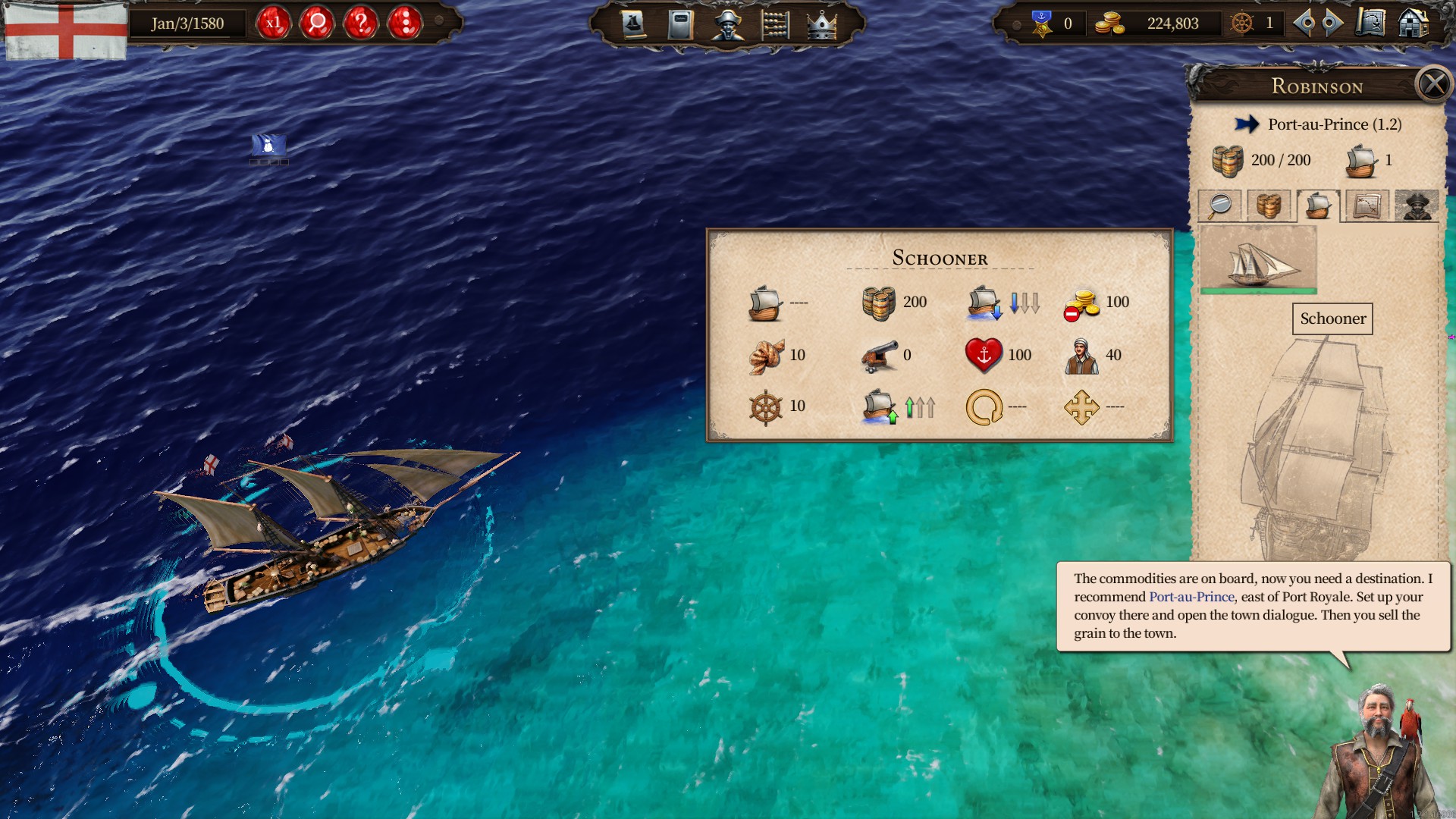
A good tutorial will let you learn at your own pace. It will teach you what you need to know when you’re curious about it, or when you need to know it. If you have a forced first campaign like this game does, it’s a good idea to just include the tutorial with the first few missions of the campaign itself so you can play around and go about it as you need to learn things, often just adding tooltips to menus explaining things the first time you open them, or showing intractable buttons where they may not be obvious to new players.
Text should ideally be hyperlinked like a wiki (or an actual wiki) so that players can follow descriptions of key terms to what they need to know if they are unfamiliar with something. Text can be read vastly faster than it is spoken, and you don’t have to wait through the interminable “jokes” to be over.
This game goes the route of having its stupid talking head blab at you and then forcing you not to be able to play with the interface in a consequence-free environment, because you might learn too much that way. Instead, you have to sit there and wait, without having access to the time controls, until a ship goes from one point to another at the lowest speed settings. You cannot skip the stupid jokes that don’t actually explain anything about the game. He even makes you buy an explicit (yet unmentioned) amount of a given product at one point, and if you don’t buy the exact amount he wants (even though it’s more than you should be buying at a given point in time), he’ll say you did it wrong and restart the whole section.
That said, there is one good thing about the tutorial section, and that’s that it actually gives you a chance to fight a battle completely on your own with no permanent consequence to get players used to the new combat system. This is the kind of sandbox learning environment that tutorials should be designed around being, rather than locking out literally the entire interface but the one button you want players to use followed by being forced to stare at the game as it plays itself for three minutes.
On that note, the tutorial often says vague things that hint you can do things, but not how to do them. At one point during the combat tutorial, for example, it says that you can switch the order that you move your ships in. Finding this useful, I then tried to click on those ships… nothing happened. I looked around for icons of the ships I could click on… but they don’t exist in the interface. I wound up going online, and it turns out you have to double-click on the other ships to select them! Gee, isn’t that sort of “what you have to press to do the thing” sort of information exactly the sort of thing that tutorials should be telling you?!
The tutorial also, for example, tells you how to create a trade route and use the default settings, but doesn’t go into what the totally undescribed stars or green boxes do on the automation setting or how to handle things manually (and again, it’s listed as a “difficulty option” to have to do things manually). This is the kind of important, detailed information that tutorials should be covering when you have a separate tutorial section that players can access at any time, but because they wanted to have a pointless voiceover, they had to keep everything vague in case the rules changed in a patch and they didn’t want to pay a voice actor to redub the lines. That being again, one of the prime reasons to never have voiceovers in a tutorial!
This is a textbook case of how not to make a tutorial. No wonder they had to hold content hostage and give out cheevos just to get people to suffer through it!
Oh, and speaking of forcing players to suffer through something extremely long to get to something they might have wanted to play instead…
Campaigns
The campaign section of the game has four campaigns; One for each colonial nation represented. Each of these is locked until you complete the Spanish campaign. There is no way to bypass this, besides maybe adding some sort of save file from off the Internet to your game files. (Unlike something like Starcraft 1 having a preferred campaign order, but letting you go through the campaign out of order if you hit a “yes I’m sure” button.)
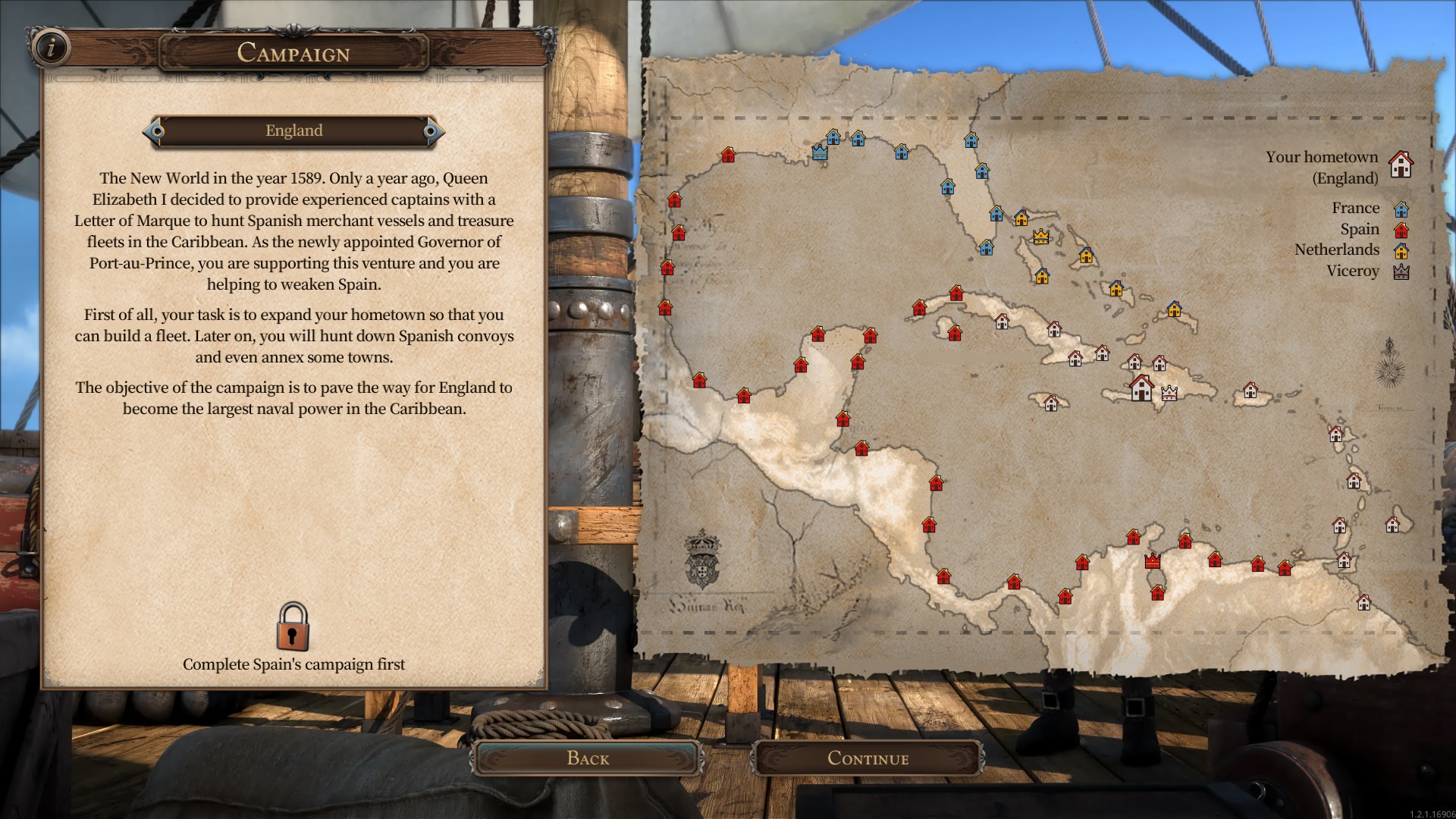
The reason this is a problem is that, depending on the level of automation you use, your first campaign will probably run you 50+ hours. You could certainly go for less than half that time if you leave everything you can to automation and just focus upon getting through it, but most players will try to explore the game rather than just beat it and get it over with.
Now, remember how I said that the problem with this kind of game where you just get wealth so you can spend it on buildings that give you more wealth is that when you reach the end-game content, you just get bored? Well, Port Royale 4 actually has the good idea of offering four different campaigns where there are different focuses you can go after. The English are the combat faction, the Netherlands are the trading-only faction, the French are the treasure hunting and city-building faction, and the Spanish are the balanced faction. Now, if there’s a playstyle that appeals to a given player, why wouldn’t they just pick the “I wanna pirate all day in this supposedly pirate game” and go with it? Too bad, you have to complete the whole 50+ hour Spanish campaign first!
The simple fact of the matter is, I don’t think too many players are going to want to start over again from scratch. They’re going to play one campaign and then quit because they don’t want to go back to nothing and having to earn basic abilities like being able to have a captain or allowed to build rope factories all over again. You set up campaigns (and let players pick characters with specific bonuses) that let players choose their playstyle, so why prevent players from playing how they want to play until they jump through a lengthy campaign first?!
Even if you don’t trust players to know what they enjoy doing on their own without your hand-holding (which is a stupid move guaranteed to generate resentment, anyway), make it so that the first campaign is a campaign with tutorial bits at the beginning that includes a small amount of everything so players can learn what they like, and then unlock all the other campaigns after doing a few missions you could easily complete in a couple hours. Or, just make it a tutorial campaign for Spain, and then the real one, and make it the actual campaign so you can have a real campaign for Spain for those who like the faction.
Especially compared to previous games like Port Royale 3 and Rise of Venice, there are some real jumps in the amount of work it takes to complete tasks in this game. Rise of Venice would have you gain three combat-capable ships for one task, then win a fight with the next task, then just get some more trading licenses in the next. In this game, it starts out with an easy set of tasks, and then jumps straight to owning 12 factories, none of which are even suited to your starting town, meaning you need to expand into completely new towns to even start. This seems to be enabled by the way that ranks have been replaced with the fame system overall.
Free Play
In any event, there is also a Free Play mode for the game. While you have less opportunity for fame points as there are no scripted tasks with rewards in them, the lack of any serious narrative in the campaign games means that this really feels like the way that the game was always supposed to be played.
One notable thing about Free Play, however, is that they have a rather granular level of “difficulty options”, although some of these “difficulty options” seem very dubiously tied to actual difficulty…
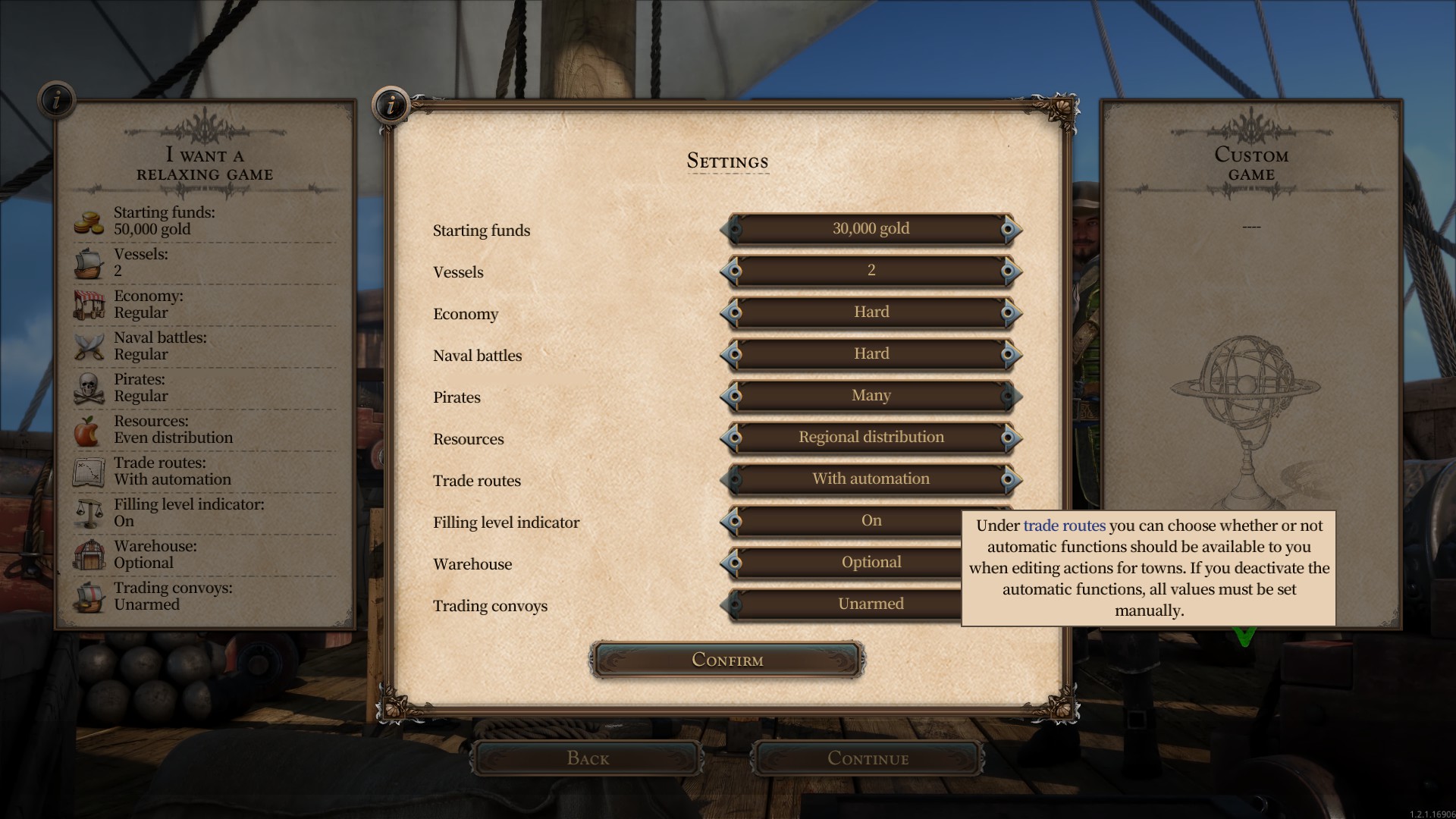
Randomizing the raw resources and whether they appear in clumps seems fine enough as a way to make games fresh (although I think you might want to start including randomized towns, or even include a geography randomizer at that point, like how Europa Univeralis had a DLC to randomize the New World), and there are difficulty options to finally make the trading and combat game not a total snooze.
That said, it is not a difficulty option to simply turn off automation, it’s a “make the game tedious and boring so you have less fun” option. The “filling level indicator” being off literally does nothing but make you have to pay a few more seconds’ attention to the price changes as you slide the bar around, as the important prices (zero bars, two bars, and four bars) all involve massive price plateaus that are impossible to miss. I do not understand why this was included here. It’s literally tearing out one of the best features this game has to offer, and calling it a “challenge mode”. Imagine if an FPS had a difficulty setting, but instead of actually making the game more difficult, it hid the health and ammo indicator.
The same goes for turning off the trade route automation setting. What this actually does is force you to manually set values like prices at which you buy and sell, which means having to write down on a post-it note what the proper buy and sell prices are for every good. Because this game franchise that pioneered automating the boring rote input of numbers part of trading to allow you to focus your attention on the fun parts of managing a trade empire is now in the hands of devs that think following rote protocols is “challenge” and this game should be “challenging”, you now have to input these numbers by hand on every single port in every single trade route you set up. (And you’ll set up dozens of trade routes with 5-20 towns visited, each.)
The “challenge” rating on the economy is likewise just a “how much grind is required” setting. “Very Hard” effectively makes you have to pay four times as much for new ships, triples the times ships take to be built, and similarly inflates the prices of various licenses you need to get on with the game. The amount of money you make trading in the economy is ironically almost totally unchanged, so it’s main impact is literally just making you set the game speed up higher and letting trade routes make money without your input for a slightly greater period of time between purchasing new ships, although it does cut prices down a bit across the board, making factories less profitable. That said, factories are often more a means of creating more goods to profit on trading elsewhere than just a means of printing money in their own right.
“Challenge” from starting settings similarly just makes you spend the first month building up to the cash you’d have if you started with the “easier” starts. The difference between starting with 30k and 50k is literally an amount I make in two stops with my starting schooner. Truly, a “challenging” start!
Even settings that shake up gameplay, like regional goods or pirate frequency, can actually make the game easier for players who understand how to use them. Regional goods means it’s easier to find missions where towns are out of specific goods that are region-locked, which you can farm for easy Fame. Pirates are only a threat if you don’t have the military strength to oppose them, but they’re free XP if you have a hunting fleet with nothing better to shoot.
The only, and I mean only “difficulty setting” that actually directly makes the game harder or easier is the naval combat difficulty setting… which mostly just gives the enemy a damage boost.
On another note, Free Play mode also gives you various settings for who owns what cities in the Caribbean from the start of the game, including having settings for how much your home nation owns at the start. (As you are locked out of being able to buy certain privileges like controlling a city if it is not part of your nation, this can seriously change how you play the game.)
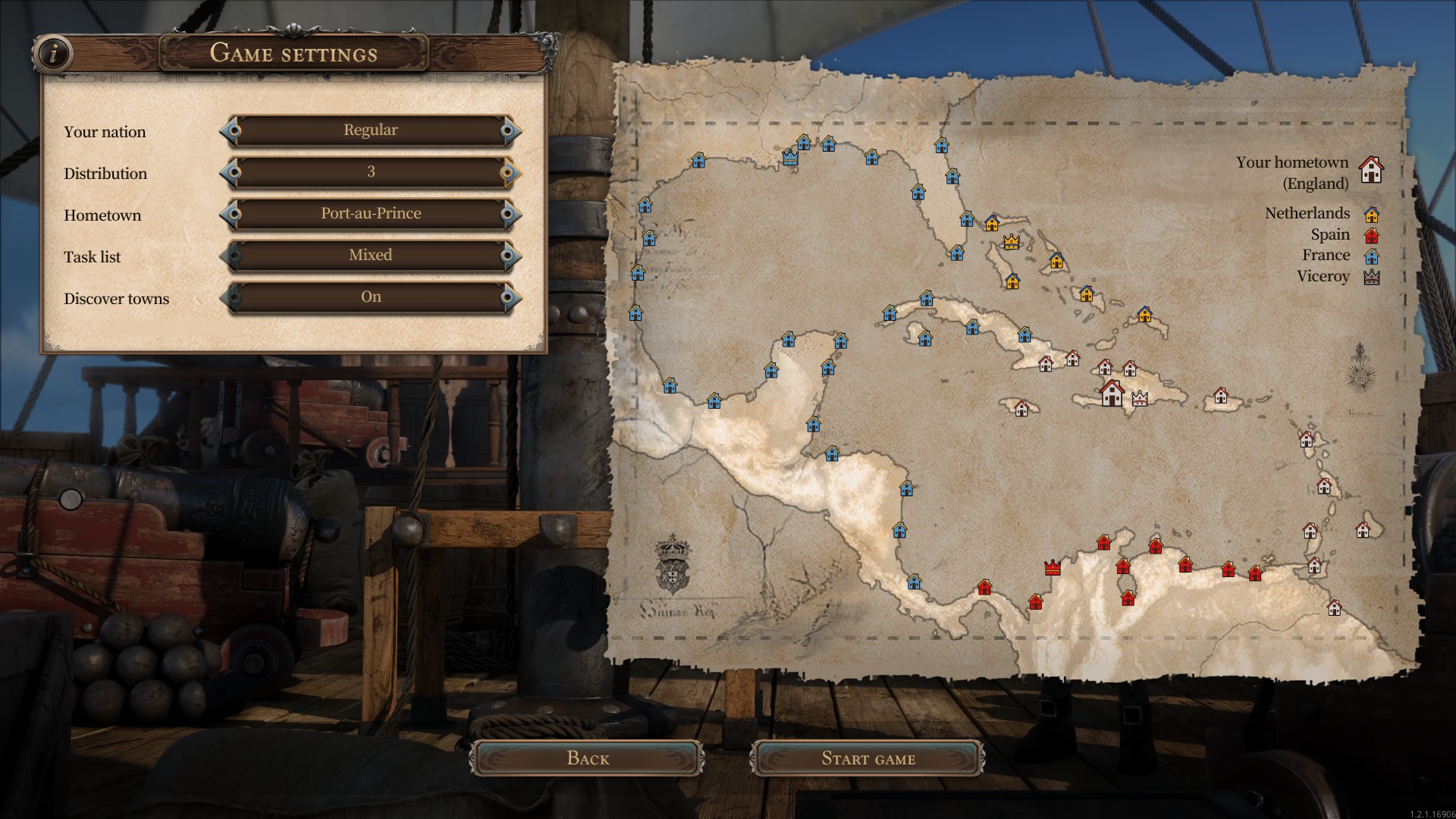
UPDATE: In release 1.3, several new options were added. One allows for “Economic Shocks”, which include things like famine disasters from previous games that impair production of specific goods in a specific region of the map. Another allows you to change whether wars are common but short or rare but long.
Linear Narrative Plot
While it may sound counter-intuitive for me to say this, I’m sure glad there isn’t any! The scripted narrative in games like Port Royale 3 and Rise of Venice were always the weakest parts of the game. This is a sandbox game series whose best ability to tell a story is procedurally through the mechanics simulating a world that reacts to your actions. Making some scripted story where you play as someone only referred to as “the young man” and fall in love with the daughter of the viceroy at first sight before she gets kidnapped and you need to fight a string of pirate captains to get her back is extremely tedious and forced in a game that should be about forging your own destiny.
Missing Procedural Storytelling
By far the biggest disappointment about Port Royale 4 overall is how it seems to be continuing Gaming Minds’s trend of stripping away the magic of the simulationism that sucked me in to Patrician 3 years ago, and replacing it with “gamey game” systems. In Patrician 3 (or even Port Royale 3), there was nothing you needed to buy a ship and set it off trading besides money and to hire a captain and crew. (Alternately, if building one new, you needed products like wood and rope, but that was still within the simulation.) With Rise of Venice, the game had gateways to doing things that any merchant should have access to, like buying and selling products like bread, until you reached a certain (absurdly high) rank that other traders clearly did not need to abide by. This is clear video game logic destroying the illusion the verisimilitude of the world the game was structured to create.
What I really wish they had done instead of investing time into story or this stupid Fame system is spend the time setting up more simulationist elements to the game. In Patrician, you could get married, but all doing so did was give you an influence bonus to people your wife had sway over and maybe help you get promotions.
Take a cue from Paradox games, and introduce some random events or even procedural storylines that make you react to the world around you. The system by which nations can randomly be at war with one another and start invading the ports of other nations, potentially upsetting trade lanes is a good example of a dynamic storytelling element in the sandbox game’s mechanics already – expand on it.
As an example of how to expand the game’s mechanics in a manner that is simulationist, maybe make the natives actually exist, and have elements relating to how positive or negative your interactions with them are, like how Europa Unversalis does. If you don’t manage relations well, there can be a native uprising that damages the town, and you may need to keep soldiers garrisoned that require pay and supplies. They could also be used for defending your port from invasion, so having city defenses be a part of the game could certainly be a welcome addition to gameplay.
The gold standard of procedural storytelling, of course, is Dwarf Fortress, a game where every random character has a dozen personality quirks even when some of them are purely good or purely bad, or others have no impact at all. I would never expect Port Royale to be as detailed as Dwarf Fortress, but adding some character to the random traders would make the game feel more alive. Have generic trading companies exist that actually do things and try to horn in on your business. Heck, partner this up with that marriage system from before, and be able to marry into a joint partnership with one of the other trading companies that are now entities that are tracked instead of just being random no-name “merchant” convoys. This is something much simpler games than Port Royale could do 20 years ago.
No Multiplayer
There is no multiplayer and there are no plans to add it.
I am generally a single-player person, so this doesn’t impact me terribly much, but the Gaming Minds trading games have always had multiplayer up until now, and the game’s systems are still built with competitive multiplayer in mind. (The automation mostly helps with not being able to pause the game, for example, and having four colored colonial nations helps set up four competing players of different nations.)
If you were looking forward to a multiplayer game of trading empire competition with your friends… well, the Patrician games are dirt cheap when on sale and go on sale constantly!
Sound
The music in the game is very subdued and in the background at most times. In some patches, you barely notice it’s even there. The soundtrack is also not on Paradox’s hundred-hour soundtrack level, so you’re absolutely going to be listening to repeats of the same music within your first few hours. You’ll probably wind up playing your radio or MP3 player while playing this game.
So far as sound effects go, when you zoom in near a port, you hear seagulls. Cannons go ‘boom’. There’s nothing to complain about (except I eventually want to shut the damn birds that keep making the exact same squaks every 10 seconds up, too), but it’s nothing terribly exciting. These sorts of management games aren’t really driven by their soundscape, ultimately.
Graphics
Here’s what it looks like if you really zoom in:
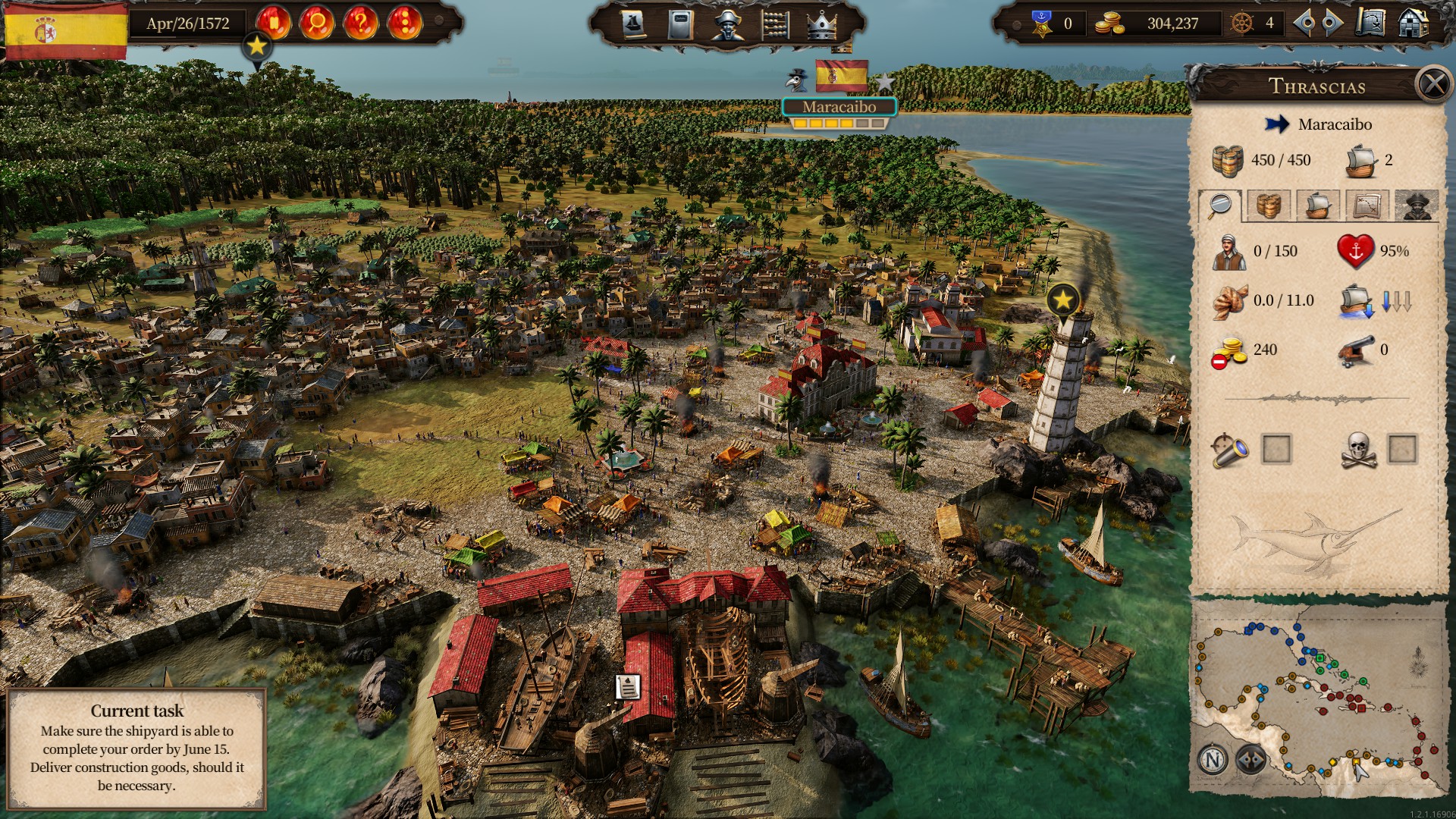
See it? Well, that might as well be called “screenshot mode”, because there’s basically only two zooms you need: All the way out, and just close enough to enable the city-building.
Many management games have this problem, but Port Royale 4, compared to its predecessors (besides Rise of Venice) has been excessively pared back in its simulationism and attempts to make the game world feel real. As a result, you’re playing a spreadsheet game that, if you for some bizarre reason wanted to, you could zoom in to see the detailed models, but the developers have done everything in their power to ensure the game design means you’ll never want to do so. In Port Royale 3, you had to go into a town screen, then see a star marking a new random task on a tavern, then go to the tavern, and there was a pop-up showing the inside of a tavern with some character offering you that task. In Port Royale 4, it’s a star with a text box popping up on the bottom left of the screen from the fully zoomed-out world map. The entire island of Hispaniola itself is apparently offering you a task.
Report Issue
While it would generally be a good thing to have such a feature, it’s notable that Port Royale 4’s options menu has a new button I didn’t see in any previous iteration of the series…
As of writing this, Port Royale 4 has “mixed” reviews on Steam, and a lot of them have to do with the broken nature of the game’s automation settings, in particular leading to some ways to actually lose the game due to a new gamey “feature”. Specifically, you lose fame if you aren’t running a controlling interest of all trades taking place in a town you administer, and this penalty is so massive it effectively means that you cannot gain any further Fame Points to acquire those basic game features you need to properly play the game if even a single town has this penalty running. Again, a major problem is that you don’t control who trades with a given town, so players have had to resort to artificial, gamey responses to this artificial, gamey problem introduced by the developer, such as selling goods to the town even when the town is at a glut and they’re selling at massive losses, just to avoid the Fame bleed.
Gaming Minds, Please Fix These:
Many elements of the interface are missing basic quality of life features like being able to set up new templates to add to trade routes. The “Standard” button that makes ships buy and sell is great, but how about letting us set up our own scripts we can apply to a town, like “load all” on a warehouse town?
Every time I go into the warehouse, the “set all” button is set to buy at 80% and sell at 100%. In reality, that needs to be buy at 110% and sell at 150% at the least. There’s no way to set what the defaults should be, and I recall there was a way to set those in the options in earlier games.
There aren’t notifications of important problems like warehouses being full or you suffering from the crippling “less than 40% market share” Fame leak. Even Rise of Venice got this right, having verbal cues saying that there was a problem with Zara and a much bigger icon describing exactly what the problem was in the tooltip.
Warehouses just don’t seem to work at all in this version of the game. I have 300 wood in a warehouse set to sell at 60 coins minimum. The town is out of wood and buying wood at 66 coins. The warehouse sits there and does nothing.
The automation in general seems bizarrely incompetent and randomly sails with an empty hold before filling up to the brim in another loop. I wind up having to turn automation off because I just can’t trust it. The automation system needs vastly more transparency. What do stars or green blocks even mean in this interface? There’s absolutely no instruction on them, so if I use automation at all, I can’t touch them because I have no idea how to measure what they do.
Ultimately, I think the Fame system in its entirety should be ripped out of the game. Especially due to requiring 10 concessions to build every factory (and remember, it takes a concession to get a captain slot and a captain to have any combat ships at all, which is needed to engage in any of this so-called pirate game’s piracy gameplay) while at the same time the game is balanced to demand you build every type of factory once before building the second of any other factory. Because it winds up taking in-game years to fill up a Fame Point bar after the first half-dozen points, during which time the player largely has to sit back and let the game play itself on autopilot without expanding so as not to unbalance the economy, the Fame system serves as nothing but a boring time sink killjoy.
I can see a system where you need to gain “your nation is happy with you” points to buy the really big, important ships your nation can build, like a British Ship of the Line being a prize costing a high number of Fame (not Fame Points, just Fame, and make it all one big pool), but basic gameplay features like being able to build common buildings should not be locked behind years of grinding. We don’t need that sense of Pride and Accomplishment for being able to have pottery kilns.
Verdict
If they fix the problems with the automation like the warehouses bugging out, this game would at least be better than Port Royale 3. I still find Patrician 3 to be the high point of the series that Gaming Minds has never been able to live up to, however. With Rise of Venice, I wasn’t angry, I was just disappointed. With Port Royale 4, so long as they make the warehouses work, I can get that up to not being disappointed, and just accepting. It could be a better game in ways I can easily see, but it is still a good game, a game I can certainly see myself playing for dozens of hours and generally being happy with. Port Royale 4 is like Euro Truck Simulator – it’s a “zone out” game where you just focus upon a few minor goals immediately ahead of you at a time, and gradually build your way up. As a mind-off “zone out” game, it works. It’s just that it could be a creative and engaging game, and it’s sad to see the potential be wasted to create these “gamey game” loops instead of creative simulations.
Previous games in the franchise had at least the touch of a RPG to them. They simulated the world as best as the limited hardware could do, letting you go into taverns or governor’s mansions to receive missions from characters, even if they were in crappy early 3D. The newest releases by Gaming Minds are all spreadsheet optimizers that have streamlined the business side of the game at the cost of everything else the games did to make their worlds feel alive, which Gaming Minds seems to have seen as just a nuisance standing in the way of the trade route optimization everyone fantasizes about. It’s sort of the Blizzardification of the sub-genre, where the game is much more streamlined and focused upon its “core gameplay loop”, but everything else that made the trip enjoyable has been culled. If you’re in it just for the spreadsheets, this is certainly a better spreadsheet game than previous installments… but there’s just no life left in the world.
As with some other games I’ve reviewed, I’m ultimately giving this one a “Save for Later” with emphasis on the “for Later”. It’s… fine as a game, and I would bump it up to a straight “Save” if the bugs were patched out. That said, you have to review the game that exists, not the one you hope will exist someday, so get patching, Gaming Minds, and you’ll get your full “Save”.

